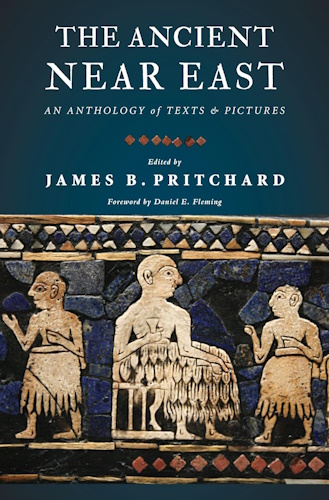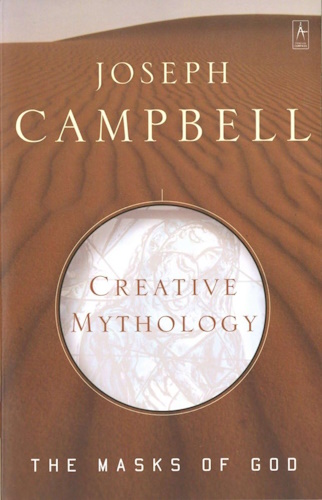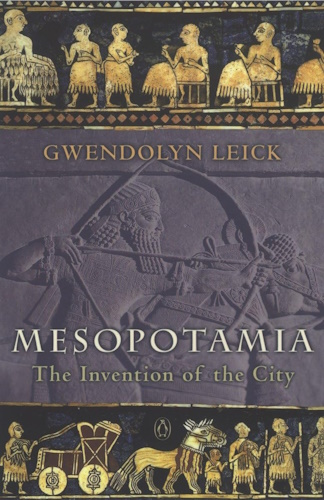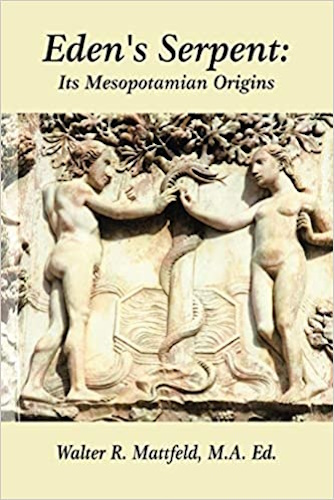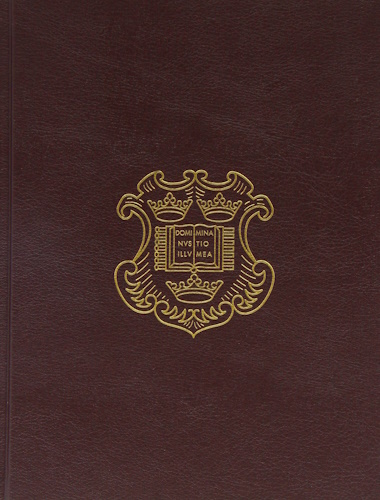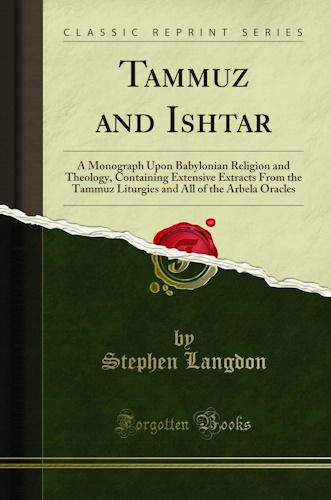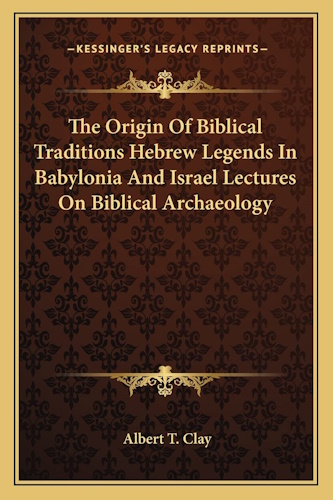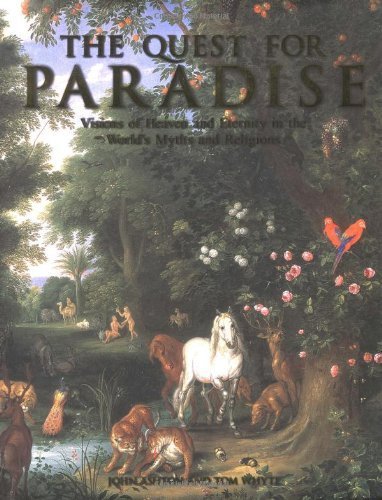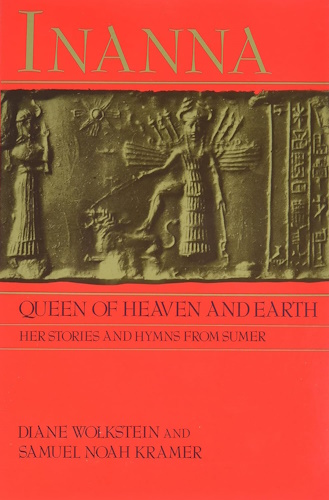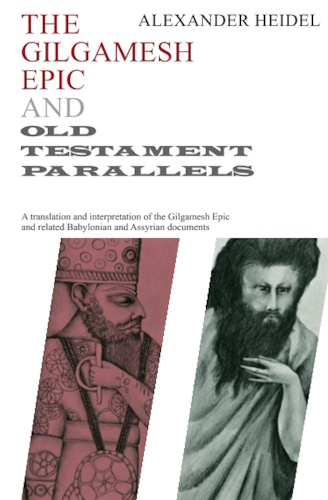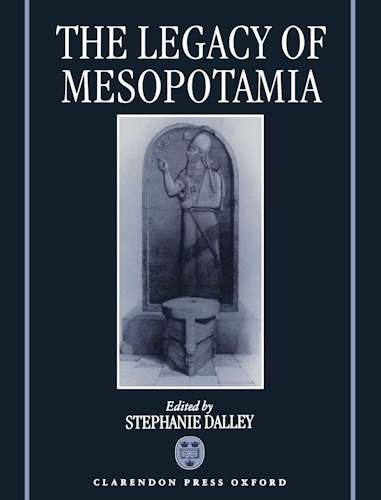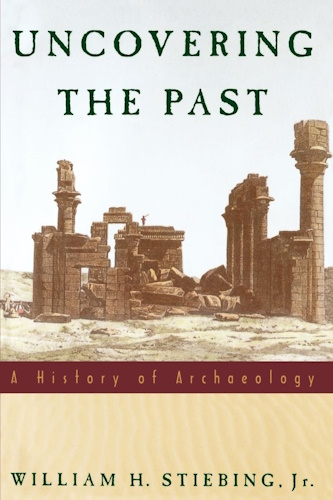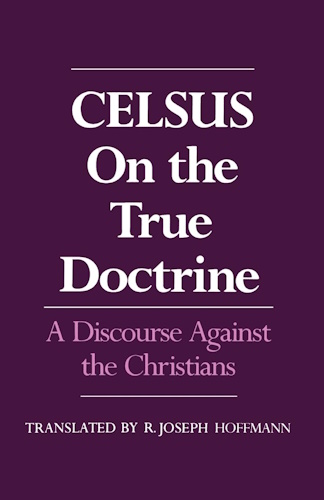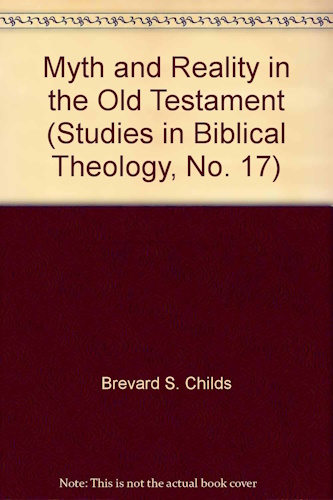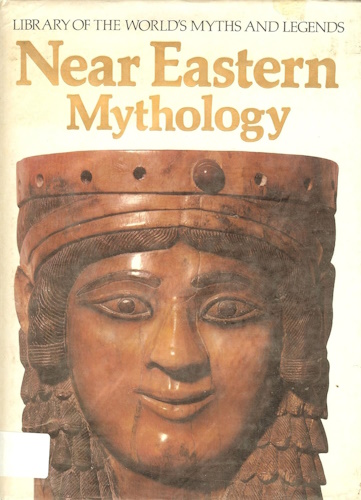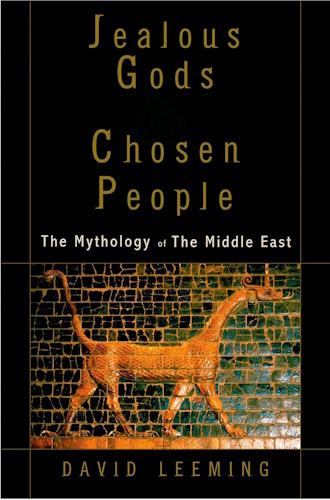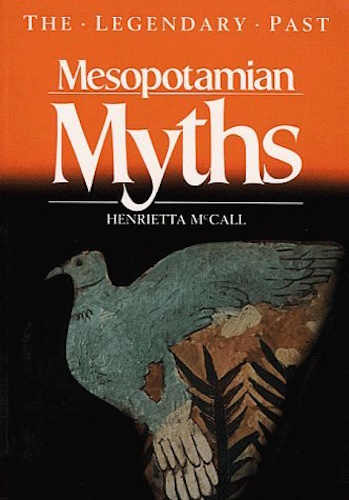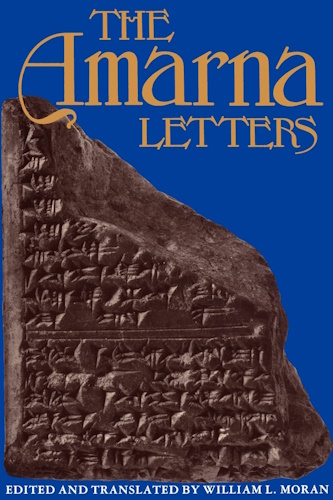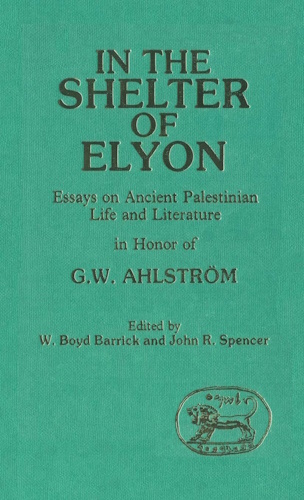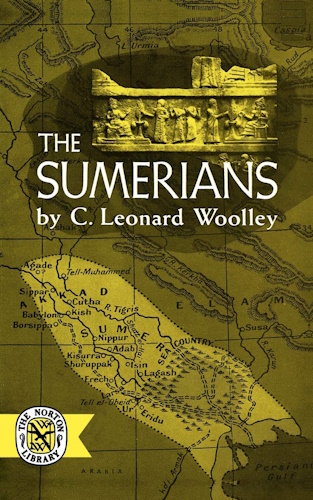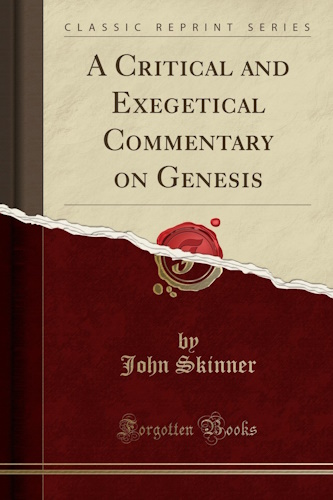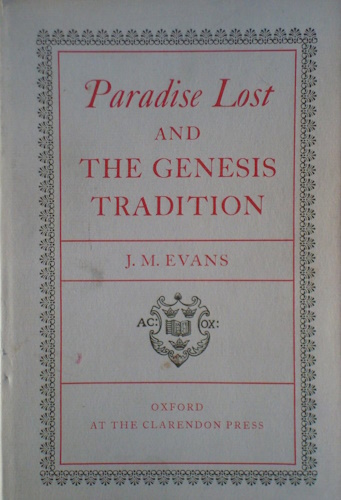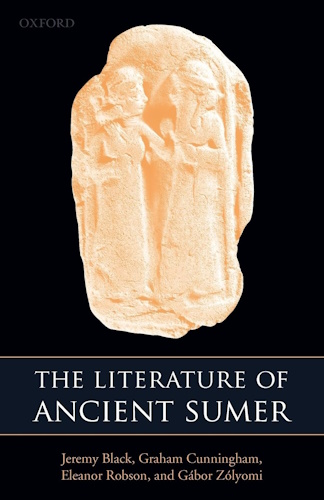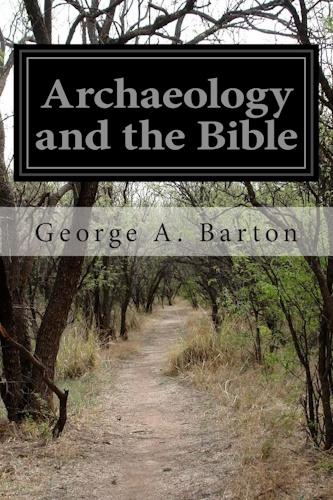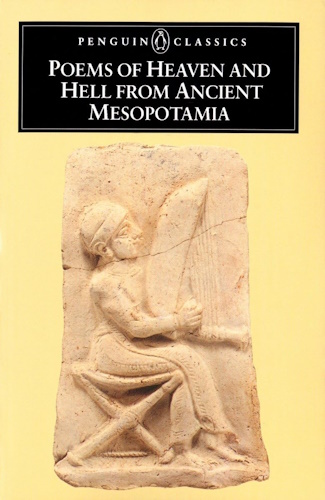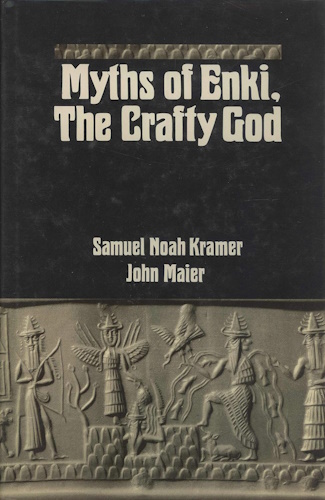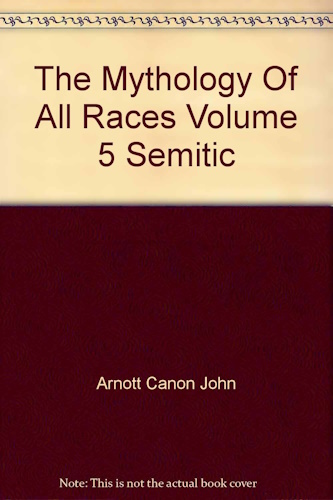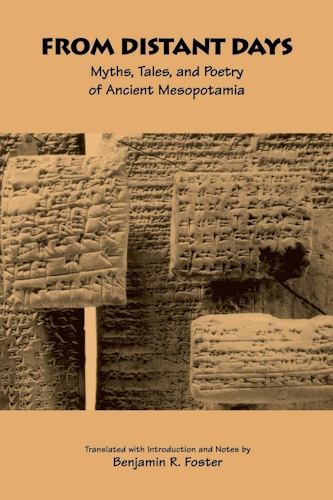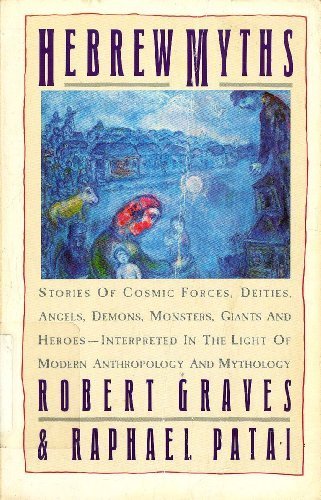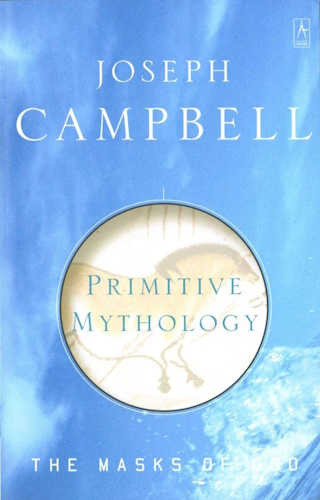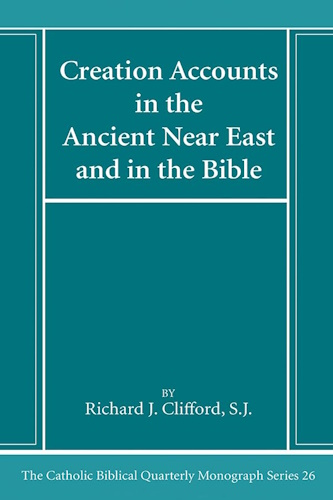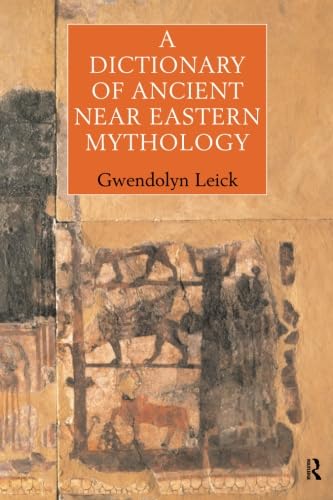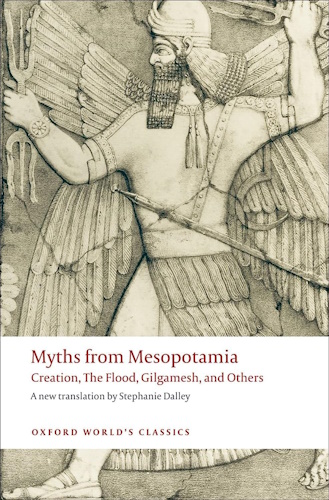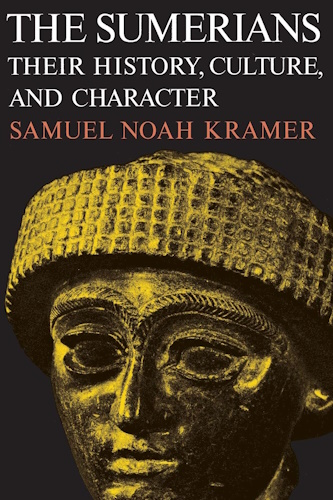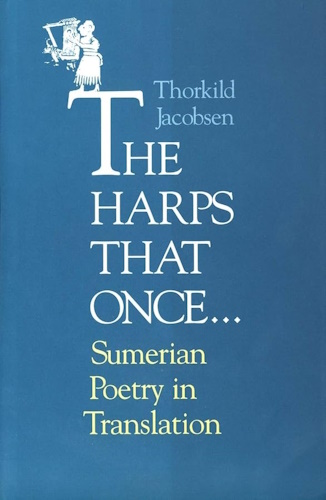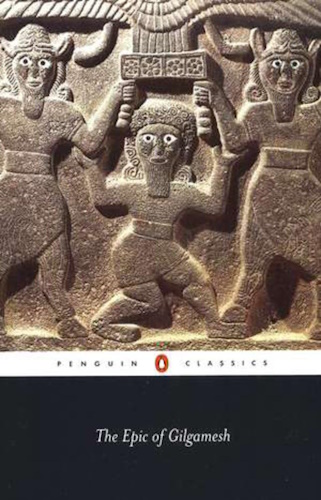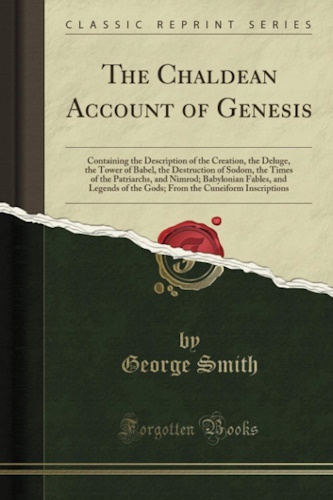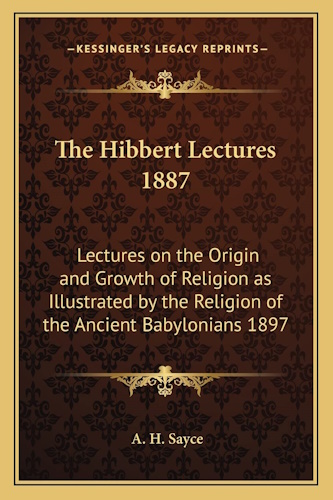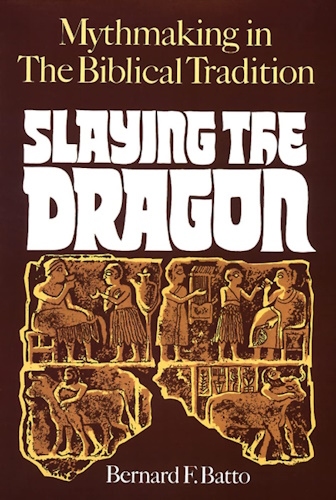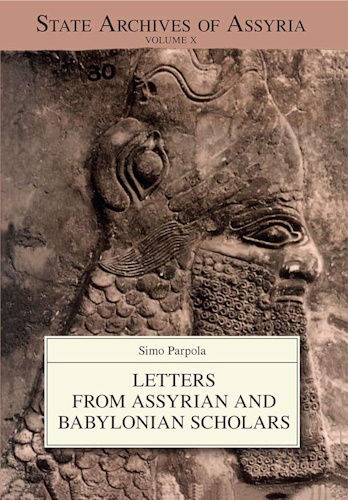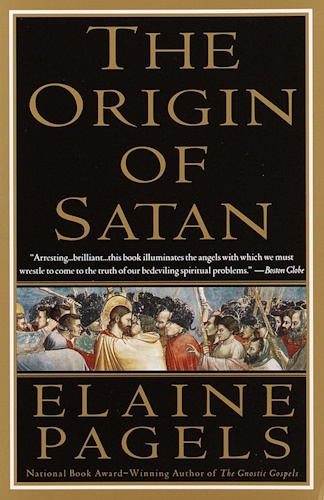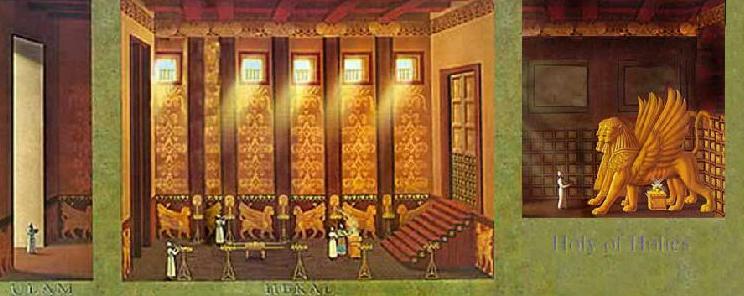![]()
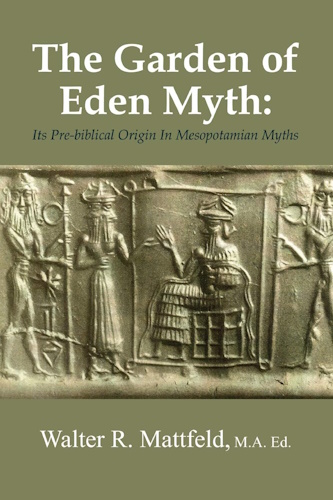
Bible Origins
The Garden of Eden's
Pre-biblical Prototypes:
The City-gardens of Eridu and Nippur
in the Edin/Eden of Sumer
Part One
by
Walter Reinhold Warttig Mattfeld y d la Torre, M.A. Ed.
e-mail contact
10 March 2005
Revisions through: 10 September 2009
![]()
Please click here for _my map_ showing the location of the Garden of Eden based on my research.
Please click here for my article identifying the Euphrates as "the river of Eden" which subdivided into four streams circa the 6th through early 2nd millenniums B.C.
This article in a nutshell:
Scenarios associated with the Garden of Eden and its two wonderous trees, the Tree of Life and the Tree of Knowledge of Good and Evil are traced to motifs associated with the city-gardens of ancient Sumer, most particularly the cities of Eridu and Nippur. Pictures are provided showing some of the fruit trees grown in the gods' city-gardens located in the midst of the Sumerian edin/eden, the uncultivated plain of Sumer in Lower Mesopotamian, modern Iraq.
Genesis denies that there are many gods, there is only one God, thus there cannot be many gods' gardens in the edin, there can be only one god's garden in Eden. The Hebrews have fused together the many city-gardens of the gods in Sumer''s edin and made them into one garden in Eden.
While this article investigates many locations as being behind Genesis' Garden of Eden, one location in particular "stands head and shoulders above all the others": Sumerian Eridug, Akkadian/Babylonian Eridu. Why Eridu? Genesis has God telling Adam "not to eat of the tree of knowledge of good and evil or he will die" and this tree is located in Yahweh's earthly garden. Numerous Liberal scholars for over 100 years have noted that motifs associated with Adapa of the Adapa and the Southwind myth appear to have been recast and assimilated to Adam and I agree. Adapa was warned by his god Ea _in_ Eridu _not_ to eat the bread of death or drink the water of death to be offered him by Anu in heaven or he would die. I understand Ea's warning to Adapa in Eridu "not to eat or he will die" was recast as Yahweh warning Adam "not to eat or he will die." Adapa acquired forbidden wisdom at Eridu which upset a god (Anu) and he loses out on a chance to obtain immortality, a similar theme exists for Adam in Yahweh's Garden of Eden. For over 100 years various PhD Liberal scholars have suggested Adapa was transformed into Adam and Eridu was recast as Genesis' Garden of Eden and I agree, but there are other locations as well as we shall investigate below. Please click here for satellite images of Eridu where in myths lived a man (Adapa) who lost out on a chance for immortality for himself and for mankind.
I understand that Genesis is _denying, refuting and challenging_ the Mesopotamian myths' explanation of Who, What, Why, Where, When and How man came to made, what his purpose on earth is, and why he does not possess immortality. I understand that the Hebrews accomplished these denials or challenges by taking motifs and concepts from a variety of contradicting myths and giving them "new twists," changed the names of the characters, the locations, and sequences of events. It is my understanding that the Hebrews were deliberately CHANGING _or_ RECASTING the earlier myths and their motifs IN ORDER TO REFUTE, DENY, AND CHALLENGE THEM, hence the "reason why" there are _no_ individuals called Adam, Eve, the Serpent, Yahweh, Noah, Shem, Japheth and Ham appearing in _any_ of the Mesopotamian pre-biblical myths. This understanding explains why there appear to be "echoes" or "parallels" or "similarities" between Genesis and the Mesopotamian concepts and motifs regarding man's creation. The Hebrews are NOT "copying" the Mesopotamian stories, they are RECASTING them in order TO REFUTE THEM.
Why did the Hebrews seek to deny, refute and challenge the Mesopotamian beliefs? Why did Christianity refute and deny Judaism? Why did Islam refute and deny Judaism and Christianity? Apparently each felt that its predecessor had wrong or erroneous beliefs regarding the relationship between God and Man and accordingly each sought to "correct" these "false" views via recastings or reworkings of the earlier stories in order to_deny refute and challenge_. For example, the New Testament while preserving verses from the Old Testament, gives these verses new meanings, rejecting the earlier Jewish interpretations. Islam recast certain stories in the Old and New Testaments, Abraham offered his son Ishmael to God instead of Isaac, Jesus is not the God who made Adam and Eve in his role as the Logos or Word, Allah is, not Yahweh or Christ.
The Sumerian myths regarding the creation of man AGREE with Genesis, Man was 1) created by a god (Enki); 2) Man was made naked and _left in that state_ for an undetermined period of time; 3) Man was placed in a location called edin which in Sumerian means "back" as in a person's back and by anaology applied to the uncultivated land "backing" or abutting the city-gardens and their fields of ancient Sumer; 4) A god (Enki) created naked man to till and tend HIS "fruit-tree garden"in Sumer in edin-the-plain; 5) Man eventually learns it is wrong to be naked and clothes himself, an echo of the Sumerian notion that the gods wore clothes, and knew it was wrong to be naked, yet they DENIED man this knowledge, allowing him to wander edin the plain without clothes with only wild animals for companions (Note: edin, edinu, edin-na, also rendered _incorrectly_ at several internet sites as e.din) is variously translated into English as a plain, steppe, or DESERT by different scholars).
The Mesopotamian art forms of the 4th-3rd millennia B.C. at times show man in a NAKED state "serving the gods." These scenes may explain why God (Yahweh-Elohim) in Genesis "keeps" Adam and Eve as his servants in a state of nakedness. I thus understand that the Hebrews are preserving Mesopotamian notions from the 4th/3rd millennia of CLOTHED Sumerian gods "keeping" man as their "servant" IN A STATE OF NAKEDNESS for a time _DENYING_ him the knowledge it is wrong to be naked; only later did he come to clothe himself as portrayed in Mesopotamian art forms of the 2d milllennium B.C. and later periods, Man being portrayed _still serving_ the gods but now in a "clothed" state. PLEASE CLICK HERE for Sumerian pictures of the NAKED ADAM, "agricultural servant" of the gods.
The Bible tells us that the Temple of Solomon was decorated with images of Cherubim guarding Palm Trees (1 Kings 6:32), which I understand to be Date Palms, the so-called "Tree of Life" denied Adam and Eve. For the Arabs Date Palms are an important food source, especially in oasis villages surrounded by arid wilderness. In Assyrian art forms a sacred tree with a Date Palm appearance is a frequent motif.
I understand that Sumerian edin the DESERT, more particularly the area known to scholars as ancient Sumer, is behind Genesis' Eden, portrayed in Genesis as an originally ARID region without any plant life (Ge 2:4-5, 10) until God provides a water source for His Garden _in_ Eden in the form of a "flood" (Hebrew ed meaning a "flood" according to some scholars). It is my understanding that Genesis is describing Iraq's ARID steppe or plain, but when the Euphrates river rises and FLOODS the land, it provides silts and water to grow Date Palm orchards and vegetable gardens, especially when men till and tend this flooded land with irrigation canals and dikes.
I thus understand that the river which flowed "out of" Eden, is the Euphrates flowing out of edin the plain/steppe, and its "floodwater" is what waters the earth, making possible a garden maintained by irrigation canals, whose duty it is, according to Mesopotamian myths, for man to tend and till. Please click here for my article and map identifying the Euphrates' "four heads" crisscrossing edin the plain in Sumer circa the 3rd millennium BCE, as possibly being the Edenic river which becomes four rivers in Genesis 2:10-14.
Both the Bible and Mesopotamian myths agree, man was created by the gods to tend and till the gods' earthly garden in edin (the floodplain). However, Genesis declares man was made to serve only ONE God rather than godS. The Euphrates is also called in the Bible "the river," I note "a river" waters Eden. How does the Euphrates become four rivers? The Sumerians believed that Enki was the god who filled river beds with water in the form of sperm from his penis, they also understood he dwelt under the earth in a freshwater ocean called the abzu/apsu and he sent up subterranean waters to fill rivers via springs or fountains. Iconographically, he is shown on cylinder seals with two streams of water gushing from his shoulders, showing he is the source of the waters for the Tigris and Euphrates rivers. Water sources were frequently shown iconographically as an irrigation pot with streams gushing forth. Some gods and goddesses have as many as four streams of water gushing from pots held against their belly. The throne Enki sits on in his underwater apsu/abzu house, in the freshwater ocean under the earth, has several pots with streams of water gushing from them, he is shown iconographically distributing these pots to Sumer's kings so that they might have freshwater for the gods' gardens near their cities. So Eridu as Enki's primary residence becomes the ONE source of the water for ALL the world's rivers! In the beginning there was only sea, then a freshwater stream erupted from the seabed, land gathered about this freshwater source, and Eridu the first city was built by Enki. So the "primitive-first-earth" was gathered over the apsu freshwater dwelling of Enki. That is to say ancient Sumer is where one of the prototypes for the Garden of Eden is to be located.
So, in Mesopotamian myths, the Anunnaki (senior gods) and Igigi (junior gods) lived on the earth, in cities which they had built for themselves, and they ate food from irrigated gardens adjacent to the cities. Genesis has _inverted this_, by having a garden in Eden by itself unassociated with a city!
Adam and Eve are punished by being _expelled from_ the garden of God to eventually live in cities built by Cain and his descendants, whereas the gods' intent was to have man dwell for all time in the garden of the gods, making irrigation ditches for it and tending the trees and crops. Genesis has INVERTED the intent of the gods vis-a-vis man, by excluding him from the gods' garden rather than living in it as an agricultural laborer for evermore! Mesopotamian myths have man created IN A CITY; in one myth it is at Nippur, in another myth it is at Eridu (However, in both locations, Nippur and Eridu, it is the god Enki who supervises man's creation) to tend and till the gods' gardens relieving the Igigi gods of caring for the Anunnaki gods' garden (its also Enki's garden, as he is the leader of the Anunnaki). This region (Lower Mesopotamia) is famed even today for its Date Palm plantations, watered by the Euphrates via canals and irrigation ditches, maintained by man. I understand that the Tree of Life in the garden of Eden is the Date Palm.
The late (1897-1990) Professor Kramer on cities being initially built and occupied by gods and goddesses and only _later_ by mankind:
"When man had not yet been created and the city of Nippur was inhabitated by gods alone, "its young man," was the god Enlil; "its young maid" was the goddess Ninlil; and "its old woman" was Ninlil's mother, Nunbarshegunu."
(p. 146. "Religion: Theology, Rite, and Myth." Samuel Noah Kramer. The Sumerians, Their History, Culture and Character. Chicago. The University of Chicago Press. [1963] 1972 reprint. ISBN 0-226-45238-7. paperback)
However, let it be said, the Mesopotamian myths at times contradict each other on details. "The Eridu Creation Myth" has the goddess Nintur, bringing man in from the plain/steppe (Akkadian seru, Sumerian edin) where he wanders naked with wild animals and has him build cities for the gods to dwell in, but note, the cities are ALSO _IN_ seru/edin (steppe/floodplain/desert).
The late (1904-1993) Professor Thorkild Jacobsen's translation of "The Eridu Genesis" (Note, I have NOT followed Jacobsen's poetic stanzas format; Emphasis mine):
"Mankind's trails when forgotten by the gods were in the HIGH (i.e., not subject to flooding) DESERT. In those days no canals were opened, no dredging was done at dikes and ditches on dike tops. The seeder plow and plowing had not yet been instituted for the knocked under and downed people. Mankind of (those) distant days, since Shakan (the god of flocks) had not (yet) come out of the dry lands, _did not know arraying themselves in prime cloth_, MANKIND WALKED ABOUT NAKED. In those days, there being NO SNAKES, being no scorpions, being no lions, being no hyenas, being no dogs, being no wolves, mankind had no opponent, fear and terror did not exist. [The people had as yet no] king. Nintur was paying attention: Let me bethink myself of my mankind, (all) forgotten as they are; and mindful of mine, Nintur's creatures let me bring them back, let me lead the people back from their trails. MAY THEY COME AND BUILD CITIES and cult-places, that I may cool myself in their shade; may they lay the bricks of the cult-cities in pure spots, and may they found places for divination in pure spots ! She gave directions for purification, and cries for quarter, the things that cool (divine) wrath, perfected the divine service and the august offices, and said to the (surrounding) regions: "Let me institute peace there !" When An, Enlil, Enki, and Ninhursag fashioned the darkheaded (people) they had made the small animals (that came up) from (out of) the earth in abundance and had let there be, as befits (it) gazelles, (wild) donkeys, and fourfooted beasts in the desert..."
(pp. 160-161. Patrick D. Miller, Jr. "Eridu, Dunnu and Babel: A Study in Comparitive Mythology." pp. 143-168. Richard S. Hess & David Toshio Tsumura. Editors. I Studied Inscriptions From Before the Flood, Ancient Near Eastern, Literary, and Linguistic Approaches to Genesis 1-11. Winona Lake, Indiana. Eisenbrauns. 1994. ISBN 0-931464-88-9)
If I am correct that Genesis is to some degree inverting and transforming the Sumerian myths about why and how man came to be created by the gods, then Nippur and Eridu is where man was first created, and these cities are in Sumer, which is in turn in edin the plain/steppe (floodplain of the Tigris and Euphrates). Enki's garden next to his shrine at Eridu, tended by man which he made, is one of the prototypes for the Garden of Eden (Nippur, too, is "another" Eden prototype). Note the word Ushumgal is an epithet of Enki's it means "Great Serpent-Dragon" (in Mesopotamian art forms the "Serpent-Dragon" has four legs that it walks upon). Thus we have here a Serpent-Dragon (Enki, "the god of knowledge") "planting" a tree, could Genesis' notion of serpent possessing legs and a tree of knowledge and a tree of life in a god's garden in Eden be recalling Enki the walking, talking "serpent-dragon" or Ushumgal and his mes-tree planted amongst the other fruit-bearing trees in his garden at Eridu in Edin-the-flood-plain, that is to say, did the mes-tree planted by Enki become the tree of knowledge associated with a walking talking serpent?
Professor Kramer on Enki's fruit tree garden at Eridu (emphasis mine):
"Lord who walks nobly on heaven and earth, self-reliant,
father Enki, engendered by a bull,
begotten by a wild bull...king, who turned out the mes-tree in the Abzu,
raised it up over all the lands,
great Ushumgal,
who planted it in Eridu-
its shade spreading over heaven and earth-
A GROVE OF FRUIT TREES stretching over the land...
Enki...lord of wisdom...you have given the people a place to live...you have looked after them..."
(pp. 39-40. "Enki and Inanna: The Organization of the Earth and Its Cultural Processes." Samuel Noah Kramer and John Maier. Myths of Enki, the Crafty God. New York & Oxford. Oxford University Press. 1989)
"...once Enki had raised up Eridu,
the mazelike mountain floated upon the waters:
at the borders flowing water was held fast
in the reed marshes;
in ITS LOVELY GARDENS BEARING FRUIT,
birds brood..."
(p. 72. "Enki and Eridu: The Journey of the Water-god to Nippur." Samuel Noah Kramer and John Maier. Myths of Enki, the Crafty God. New York & Oxford. Oxford University Press. 1989)
Crawford on ancient Sumer's GARDENS possessing DATE-PALMS, FRUIT-TREES and VEGETABLES (emphasis mine):
"So far we have been considering the relationships of settlements to the landscape and to each other, but each of these settlements was supported by its own agricultural hinterland, irrigated by canals, which separated it from its neighbours and provided the vital foodstuffs and fuel on which its survival depended. The utilised land can be divided into three categories: the intensively cultivated GARDENS, which often lay within the boundaries of the settlement on the banks of the water courses; the irrigated fields lying in a band parallel to the waterways and producing the bulk of the staple crops; and the land further from the water supply which was used as grazing, for collecting fuel, for hunting, and occasionally for catch crops when conditions were favorable...The most important crop produced by the GARDEN plots south of the Hit-Samarra line in the third millennium was almost certainly dates, although the archaeological and textual evidence for the production of dates at this time is surprisingly flimsy. Date stones are reported in late Ubaid context at Eridu (Wright 1981:324)...More date stones were found in the grave of the lady Puabi in the Royal Cemetery at Ur...There are also reports of the import of special sorts of date from Dilmun...The date palm is ideally suited to the conditions in south Mesopotamia: it flourishes with its roots in stagnant, salty water and...can be relied on to produce heavy crops south of the 35th parallel. As far north as Qurna it is not even necessary to irrigate because of the backup from the tidal regime on the head of the Gulf. The trees not only produce a highly nutritious food which is a staple part of the diet, but the sap provides a useful sweetner and can also be used to make a sort of fermented date wine...Just as important to the farmer was THE SHADOW CAST BY THE DATE PALM. This ALLOWED allowed more tender plants, such as FRUIT TREES, pomengranates, FIGS, APPLES and even vines, TO GROW IN ITS SHADE. In the deeper shade below the fruit trees were the GARDEN plots, which produced vegetables such as onions, garlic and cucumbers...These plots required much labour, but were amazingly productive. The irrigated arable land, much of it owned by the great public households of the temple and the palace, formed by far the most important category of land in terms of both area and productivity."
(pp. 52-54. "Patterns of settlement and agriculture.Harriet Crawford. Sumer and the Sumerians. Cambridge, United Kingdom. Cambridge University Press. 1991, 2004)
Kramer on "shade-tree planting" practiced by the Sumerians (Emphasis mine):
"Not only cereal farms but also vegetable gardens and FRUIT GROVES were sources of Sumer's economic wealth. One of the more significant horticultural techniques practiced in Sumer from earliest days was shade-tree gardening -that is, the planting of broad shade trees to protect the garden plants from sun and wind. This we learn from a Sumerian poem that is presented in Chapter 12."
(p. 69. "The First Farmer's Almanac." Samuel Noah Kramer. History Begins At Sumer, Twenty-seven "Firsts" in Man's Recorded History. Garden City, New York. Doubleday Anchor Books. 1959. First printed in 1956 by The Falcon's Wing Press)
Note: Genesis does not identify what tree was the "Tree of Knowledge" or what tree was the "Tree of Life." Some scholars have suggested that as Adam and Eve are portrayed covering their nakedness with FIG LEAVES (Genesis 3:7) after eating of the "Tree of Knowledge" that perhaps it is the FIG TREE. Elsewhere in the Bible, we are told that Solomon had his temple decorated with cherubim and palm-trees (1 Kings 6:32, 35). Perhaps this is an allusion to the "Tree of Life" that God sets the cherubim to guard in the garden of Eden (Ge 3:24)? If so, then the DATE-PALM was probably the "Tree of Life." Of interest here is Crawford's _above_ observations about date-palm gardens (date-palm plantations) and fig trees growing in the shade of the date palms. Is Genesis recalling a fig tree (as the "Tree of Knowledge") because in Mesopotamian gardens the fig tree grew _NEAR_ the date-palm (the "tree of life"), THRIVING IN ITS SHADE? Was the date-palm seen as the "Tree of Life" because (1) its dates were a staple food for all, both rich and poor, and (2) its "life-giving-shade" allowed smaller fruit trees to flourish, who's shade, in turn, allowed vegetables to flourish as well?
The Sumerians called fresh figs pesh-duru and dried figs pesh-had. The below account of Woolley's Ur excavations mentions date-palm plantations and fig trees in ancient Sumer (emphasis mine):
"Before the 20th century, written history had told the world very little about Ur. Beyond the Bible's brief references to it as the home of the patriarchs, almost nothing was known. But in the early 1920's the British Museum and the University Museum of Pennsylvania sent a combined expedition to Iraq under Woolley's leadership to investigate a certain massive mound of brick about 230 miles south of Baghdad. And there was Ur.
It doesn't seem possible now that Ur was ever the site of the great civilization that Woolley was later to describe: a city surrounded by bounteous GARDENS WITH GROVES OF _FIGS_ AND _DATES_ and tall palms standing by mathematically straight irrigation canals, a city of temples and warehouses, workshops and schools, spacious villas and the towers they called ziggurats, all within a great wall overlooking the waters of the Euphrates."
http://www.saudiaramcoworld.com/issue/196802/ur.of.the.chaldees.htm
Professor Potts on southern Mesopotamia's "gardens" being foremostly date palms:
"The 'garden' in southern Mesopotamia was, first and foremost, a plantation of date palms (Phoenix dactylifera, Sumerian gisgishimmar)...Date palms are eminently suited to the Mesopotamian alluvium, for no other crop in the sub-tropical zone is as salt tolerant as the date plam...no less important than the dates which it provided for human consumption...was the shade which it afforded, permitting the cultivation of most of the legumes and vegetables...as well as smaller fruit trees.
Gardens such as these were organized according to the principle of 'storeys', on analogy with the levels of a multi-story building. The upper storey comprised the date palms themselves, the tallest trees in the garden and those which provided shade for everything growing beneath them; the middle storey comprised fruit trees of varying types...the lowest storey comprised cultivated plots of cereals, vegetables, legumes or a combination of all three. This is the same principle expressed today by the Arabic term bustan, which is used specifically of a multi-tiered palm-garden with inter-cropping of the sort just described..."
(p. 69. "Agriculture and Diet." D.W. Potts. Mesopotamian Civilization: The Material Foundations. Ithaca & New York. Cornell University Press. 1997)
Crawford on THE EDIN, "uncultivated land" surrounding the Mesopotamian city gardens and irrigated fields being utilized by shepherds to graze their flocks and herds (emphasis mine):
"The third category of land which we listed at the beginning of this section was the unirrigated land, which lay furthest from the waterways, and which merged into the unused land referred to in the texts as THE EDIN. This empty land formed a buffer between one settled enclave and another. It also had a considerable economic role. For much of the year it provided valuable grazing for the sheep and goats, which supplied both meat and dairy produce, as well as wool for the important textile industry. In the summer months the land yielded nothing more than a little scrub, but plants with deep roots, such as prosopis, survive on very little moisture and provide not only a little meager grazing, but also small quantities of fuel, as does the dung dropped by the animals. This is mixed with chopped straw and dried and today provides a major source of fuel IN A VIRTUALLY TREELESS ENVIRONMENT."
(pp. 57-58. "Patterns of settlement and agriculture." Harriet Crawford. Sumer and the Sumerians. Cambridge, United Kingdom. Cambridge University Press. 1991, 2004)
Genesis suggests God plants a garden _in_ Eden with fruit trees (Ge 2:8-9). Crawford's above observation of THE EDIN BEING A TREELESS STEPPE OR PLAIN, which SURROUNDS AND IS CONTIGUOUS TO THE GARDENS OF THE GODS WHICH POSSESS FRUIT-TREES, APPEARS TO ME TO BE A MIRROR-IMAGE OF GENESIS' GARDEN. IN THE MESOPOTAMIAN MYTHS IT IS THE GODS WHO PLANTED THESE GARDENS _IN_ THE EDIN _BEFORE_ MAN'S CREATION. THE GODS PLANTED THESE GARDENS TO PROVIDE FOOD FOR THEMSELVES AS THEY HAVE BUILT CITIES IN THE EDIN TO DWELL IN. AFTER 'TIRING' OF ALL THIS LABOR, BUILDING IRRIGATION CANALS AND DREDGING THEM THEY CREATE MAN TO WORK IN THEIR STEAD, MAN WILL CARE FOR THE GOD'S CITY GARDENS WHICH ARE FILLED WITH FRUIT-TREES. I understand the Hebrews are "refuting" these Mesopotamian myths regarding how the gods came to create man and place him in their city-gardens to grow food and feed them.
However, Pollock appears to _contradict_ Crawford, in that in antiquity trees did exist "growing in the wild" near the Tigris and Euphrates on the levees created by the rivers!
Pollock noted that trees AS NATURAL FLORA grow near the rivers or channels crossing the plain on levees formed by the Euphrates. Perhaps in antiquity trees once grew wild atop/near levees? This would explain Kramer's translation from the Epic of Gilgamesh, cf. below, that has Gilgamesh coming to _a garden of the plain_ and chopping down its trees? Pollock (emphasis mine):
"The NATURAL FLORA OF THE LEVEES included dense growths of willow (Salix), poplar (Populus), tamarisk (Tamarix) and licorice (Glycyrrhiza)...Because of their good drainage, levee soils are prized for cultivation. DATE PALMS, _FRUIT TREES_, CEREALS, legumes, and other vegetables are preferentially planted on the levee tops...The soils on the backslopes and in the basins are finer in texture and lie closer to the water table than the soils of the levee top. As a result, they are less optimal for cultivation. Nonetheless, their nearness to river channels facilitates irrigation by means of short gravity-flow canals, making them suitable for growing creeals, legumes, and other vegetables...Away from the rivers, the natural vegetation is classifed as subdesert."
(pp. 32-33. Susan Pollock. Ancient Mesopotamia, the Eden that Never Was. Cambridge, England. Cambridge University Press. 1999. Fifth printing 2004. ISBN 0-521-57568-0 paperback)
I understand that the biblical Eden's "fruit trees" planted by God (Ge 2:8,15-17) are recollecting the appearance of these trees (being planted by man) near levees in the Mesopotamian plain or edin. Cereals recall the growing of wheat for "bread" by Adam (Ge 3:19). In the Mesopotamian myths, however, it is not man who planted the fruit trees, but instead the gods, who built for themselves cities to dwell in in edin the plain, and who also planted gardens of the gods adjacent to the cities. Later, the gods make man to work in their gardens, ending the lesser gods' toil in these gardens.
Of interest _to me_ is a passage from The Epic of Gilgamesh speaking of "a garden of the plain," as plain is "edin" in Sumerian (Akkadian/Babylonian: "edinu"), perhaps we what we have here is the earliest or "_first_" mention of a "garden of edin"? Also of interest is the presence of trees in this "garden of edin," the biblical garden of Eden being famed for its trees.
Professor Kramer ("Plain" being rendered as serim rather than edin ?):
"To the...GARDEN OF THE PLAIN he [Gilgamesh] directed his step,
The...-tree, the willow, the apple-tree, the box-tree, the
...-tree he felled there."
(p. 178. "Slaying of the Dragon [Huwawa or Humbaba], the First St. George." Samuel Noah Kramer. History Begins At Sumer, Twenty-seven "Firsts" In Man's Recorded History. Garden City, New York. Doubleday Anchor Books. 1959. paperback)
The late (1880-1960) Woolley on Sumer's extensive date palm gardens, and the fact that the date was a "staple" food of the people. Could perhaps the date's being a "staple food" for the Sumerians account for why it became Genesis' "tree of life"? (emphasis mine):
"The prosperity of Sumer depended on its agriculture and on its commerce. The carefully irrigated fields produced amazing crops of barley and spelt, onions and other vegetables grew along the canal banks, and as early as 2800 B.C. the DATE-GARDENS were very extensive -a number of varieties of dates were cultivated, and the harvest afforded one of THE STAPLE FOODS of the people."
(p. 112. "Sumerian Society." Sir Charles Leonard Woolley. The Sumerians. Oxford, England. The Clarendon Press. 1928, 1929)
Woolley on grain being grown in Sumer for BREAD (Adam apparently grows grain in Genesis, being told by God he will earn his bread by the sweat of his brow (Ge 3:19) (emphasis mine):
"The grain was used for BREAD ground to flour between flat rubbing-stones, or was parched and bruised for a kind of porridge or brewed into beer; wine was manufactured from dates as well as from grapes..."
(p. 114. "Sumerian Society." Sir Charles Leonard Woolley. The Sumerians. Oxford, England. The Clarendon Press. 1928, 1929)
Below, How the Garden of Eden must have looked at Eridu. The German commentary accompanying this photograph explains that the Date-palms provide shade for the smaller fruit-trees ("fruchtbaume"), which appear to the viewer's right (described as pomegranate-trees "granatapfelbaume"), below the fruit-trees are cultivated vegetables and wheat and irrigation ditches. That is to say the commentary somewhat agrees with Crawford's observations (cf. above). The uncultivated land surrounding and contiguous to the city-gardens was called in Sumerian THE EDIN (rendered variously into English as Desert, Steppe or Plain) When provided with water via irrigation the semi-arid uncultivated EDIN becomes a lush tropical paradise garden as in Genesis' Garden of Eden (for the photo-commentary cf. p. 32, the photo is on p. 33. Barthel Hrouda. Editor. Der Alte Orient, Geschichte und Kultur des alten Vorderasien. C. Bertelsmann. Verlag GmbH/54321. Munchen. 1991. ISBN 3572-00867-0).

Below, an artist's impression of Eridu in the 5-4th millennium B.C. based on archaeological findings. I understand that Eridu is one of several prototypes behind the Garden of Eden. Note the date-palms being grown at Eridu (understood to be the "Tree of Life" by some commentators). In the foreground men work on a boat. In the shadows of the date-palms men till the earth for other food-crops as noted by Crawford, cf. above. In the distance is a village of reed huts with a white plastered mud-brick temple of the god Enki (Ea) who made man in the Sumerian myths to tend and till his fruit-tree garden at Eridu. To the viewer's right is probably the sebkha-lagoon abutting Eridu's east side. Hymns mention a "Snake Marsh" that Enki enjoyed punting his boat in. Other hymns state that Eridu lies on the "shore of a Sea" and that Enki's temple is called a "Sea House". Eridu lies in a great depression called the Khor el Nejeif in which three sebkhas or seasonal lagoons form each year due to a flooding Euphrates river (please click here for a 06 June 2006 satellite photo of the three Euphrates filled freshwater sebkha-lagoons about ancient Eridu).
For the below picture of Eridu cf. pp. 61-63. Courtland Canby. Editor. The Epic of Man. New York. Time-Life. 1961.
Professor Potts (1997) citing research of other scholars understands that the term "sea" in ancient texts could on occasion refer to an area of marshes and lagoons. Eridu's "sea-house" and the "sea" it cast its shade over is the sebkha-lagoon east of and adjacent to the city, _not_ the shore of the Persian or Arabian Gulf as is commonly misunderstood by many PhD scholars Please click here for all the details.
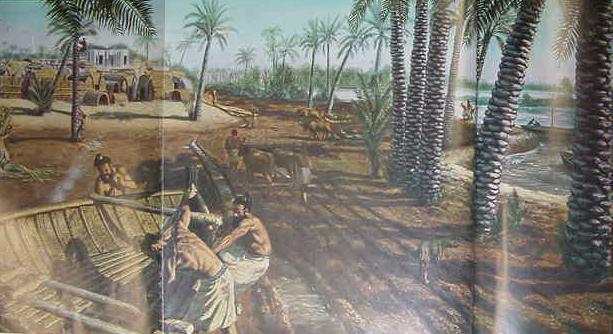
Below, an aerial photo (taken 2008) of Eridu and the remains of its Ziggurat (there are 7 mounds making up Eridu, this is only 1 of the 7). It was here that Enki created man of clay to replace the Igigi gods who threatened rebellion over the onerous working conditions in his city-garden, creating and dredging irrigation canals and ditches to provide water for it. It was here that a man called Adapa was warned by his god Ea (Enki) not to eat the "food of death" or "drink the water of death" or he would die, presaging Yahweh's warning to Adam about the forbidden fruit. Ea lied he did not want to loose his servant who fed him bread, fish and water daily. In myths gods do not feed themselves that is man's task. Had Adapa disobeyed and ate the forbidden food he would have attained immortality and become a god, thereby ending his and mankind's servile status. The Mesopotamians understood man lost at a chance to obtain immortality because his god (Ea/Enki) conned him. However Ea (Enki) did allow man (Adapa) to obtain forbidden knowledge which upset the god Anu. As can be seen below, Eridu today is quite arid and desolate. A canal once existed called the id Nun "Canal of the Prince" which brought year-round freshwater to this area's fields of barley, fruit-tree orchards and fish-filled reed-lined lagoons. Some scholars render the Sumerian word edin which means uncultivated land as "plain," "steppe," "wilderness," and "desert," the latter term well describes the present situation. I understand this site number ranks _number one_ over several other pre-biblical locations which were fused together into a single location: the Garden of Eden. For additional photos of Eridu please click here.
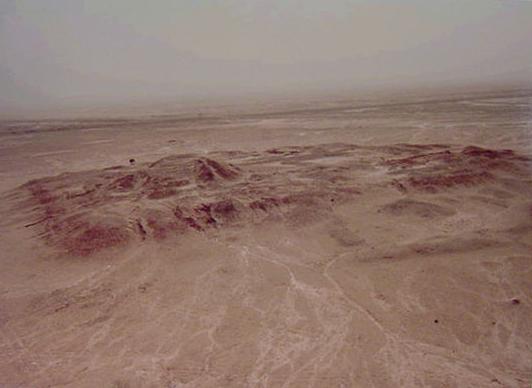
Genesis 1:29 RSV
"And God said, "Behold, I HAVE GIVEN YOU _EVERY_ PLANT YIELDING SEED which is upon the face of the earth, AND _EVERY_TREE_ with seed in its fruit; YOU SHALL HAVE THEM FOR FOOD."
Then, later, God _contradicts_ himself, Adam cannot eat of "_every_ tree," the tree of knowledge of good and evil is denied him:
Genesis 2:16 RSV
"And the Lord God commanded the man saying, " You may freely eat of every tree of the garden; but of the tree of knowledge of good and evil you shall not eat, for in the day that you eat of it you shall die."
To the degree that Genesis portrays one river arising _in_ Eden and watering God's garden, and God stations Cherubim to guard the "Tree of Life" from man's access, perhaps the 18th century B.C. wall mural at ancient Mari on the Euphrates is part of Genesis' Garden of Eden imagery? Mari's Date-palms gardens were watered by one stream, the Euphrates. Please click here for pictures of two trees guarded by fabulous winged beasts (Cherubim?). One tree is a date-palm, the other is "unidentified" as to species but it is "in flower" suggesting for me that it is some kind of a "fruit-tree" as flowers on trees usually precede the appearance of fruit. In the archives at Mari are found personal names bearing the theophoric Yahweh, as in Yawi-ila (Yahweh-El), mention of tribes called the Banu-Yamini (Benjamin?), and Haran where Abraham settled for a time.
If Eden is edin the plain (Euphrates floodplain) in the area of Eridu and the land of Sumer, where is the "land of Nod"?
Cain wanders in Nod as the world's first murderer and fugitive, fearful of dying. Such motifs in a somewhat different manner appear in the Sumerian myths. Enki has an Igigi god called We-e-i-la at Nippur slain and from his flesh and blood makes man, a-wi-lum, by mixing it with clay by his assistant the goddess Nintu (the Atrahasis Flood Myth). So, man's very creation was the result of the slaying of a divine being of flesh and blood who dwelt on the earth in the garden of the gods. The Hebrews have inverted this, instead of a god's blood being mixed in clay, it is Abel's blood that cries out from the earth to God.
In the Sumerian myths a Flood is sent because the noise or cries of man on the earth disturb their rest. In another myth, before man settled in the cities of the gods he was a WANDERER of the edin the plain with wild animals for companions. So man "the wanderer" has become Cain the Murderer who _wanders_ in fear of his life, just as Gilgamesh _wandered_ the earth in fear of dying after the death of his companion Enkidu, the naked man of edin who had animals for companions.
Cain is credited with building the FIRST CITY called Enoch (Hebrew: Chanoch), in the Mesopotamian myths the FIRST CITY is built by the god Enki (Did the Hebrews transform via a puning or word play, Enki into Enoch?). Cain, Hebrew qayin, slays a man, Enki slays an Igigi god and makes man of his flesh and blood mixed into the clay. I thus understand that the Hebrew nwd meaning "wander" is an echo or allusion to the early Mesopotamian creation myths that had man originally a naked animal wandering seru/edin the plain, before the goddess Nintur took pity on him and had him build cities to house the gods (contra Enki's building a city). So, for me, _the land of Nod is edin the plain_. Enki's slaying of a god to create man at Nippur to be placed in the god Enlil's garden to relieve the Igigi gods, becomes Cain slaying Abel.
In the Atrahasis Flood myth it is "warrior" Enlil/Elill who determines man must be destroyed by a Flood. Contra Enlil's order for no one to warn mankind of the impending flood, Enki warns the pious Mesopotamian Noah, called Atrahasis, to build a boat to save himself, family and animals. That is to say, I understand that Genesis' Yahweh-Elohim who sent the Flood and who warned Noah of a Flood, is a fusion of two gods, the Sumerian Enlil (Akkadian/Babylonian Elill) who sent the Flood, _and_ the Sumerian Enki (Akkadian/Babylonian Ea) who warned a man of the Flood! This also means that man's creation at both Nippur and Eridu to work in Enlil's and Enki's earthly gardens, have been fused together in Genesis, just as Yahweh is a fusing of Enlil and Enki! So, we have TWO locations fused together for the "garden of Eden," Nippur AND Eridu (both lying in edin-the-floodplain of Sumer).
A number of Genesis' motifs appear in earlier Sumerian myths about earliest man and how he came to be made and where, but in a transformed and reinterpreted manner. Enki has become Yahweh-Elohim AND one of several prototypes of Adam in the Dilmun myth. Many think Dilmun is an Eden prototype, and I agree that is _one of several prototypes_, but even this location is portrayed as a _CITY_, with a king, canals, irrigated gardens for Date Palms, lagoons with fish and marsh reeds and boat quays or docks, in harmony with the Sumerian notion that the garden of the gods, that man was made to till and tend, was ALWAYS associated with a city.
In reality "Eden-as-Eridu," was not created by the gods, men settled here in the 6th/5th millennium B.C. and by the sweat of their brows transformed this area into a "garden of the gods," via the building of canals and irrigation ditches for crops. Over several millennia they thrived and became a metropolis. The Enki hymns mention his Abzu house casting its shade over marshlands filled with reeds and fish, probably formed by the Euphrates in antiquity. Some scholars understand the head of the Persian gulf may have been Eridu. I suspect its where it has always been. I suspect that the "SEA" Eridu casts its shade over is the seasonal freshwater sebkha lagoon abutting Eridu's east side. This lagoon reaches maximum flood stage in late May due to the flooding Euphrates river. But the river diminishes in its flow later and the water-filled lagoons evaporate away in the hot summer sun leaving no freshwater for man and his crops. Only with a canal linking to the Euphrates are men able to live at Eridu year-round. Eridu was _abandoned_ several times because it could not sustain human life without a year-round source of freshwater, a man-made canal linking the Euphrates to the area. When the canal; ceased to be maintained the site would be abandoned. Perhaps the site's abandonment by man was recast as God casting man out the Garden of Eden?
The following verses suggests to me that the Sumerians saw the river Euphrates as being also a SEA. Thus Enki's Eridu "Sea-House" sits on the western edge of the seasonally formed freshwater Sebkha-lagoon. The Egyptians had a similar concept. They called the Nile iuma, meaning "Sea" (compare with Hebrew Yam "sea") because each year when the Nile flooded the delta the area looked like a vast sea (the Arabs still call the Nile, Bahr Nil, "SEA NILE"). No doubt the discharge of the Euphrates river in antiquity, especially during the Spring flood time, created a vast marshland "sea" or delta near Eridu.
Kramer:
"House of Enki...
Sea House with reed hedges tied together by Enki...
Abzu, pure place...
Eridu, beloved of Enki,
Sea House... BUILT ON THE EDGE...
Eridu, whose shade stretches over the midst of THE SEA,
the billowing SEA, unrivaled,
THE HIGH RIVER, AWESOME, that strikes terror in the land,
Sea House, powerful... house by the SEASIDE
a lion in the midst of the Abzu...
your din, like the rising high river,
makes music for Enki...
Once Enki had raised up Eridu,
the mazelike mountain floated upon the waters:
AT THE BORDERS FLOWING WATER WAS HELD FAST
IN THE REED MARSHES...
Enki rose... He stood at the Abzu...
into the Sea House he brought joy,
into THE SEA put fear,
in the HIGH RIVER CREATED TERROR,
raised up the South Wind raging over the Euphrates."
(pp.71-72. "Enki and Eridu: The Journey of the Water-god to Nippur. Samuel Noah Kramer and John Maier. Myths of Enki, the Crafty God. New York & Oxford. Oxford University Press. 1989)
Brian M. Fagan on the present aridity of Sumer and Eridu and Eridu's location which he, in error, thinks is on a "sea estuary".
Fagan, Professor Emeritus of Anthropology, University of California, Santa Barbara (emphasis mine):
"Today, Sumer is desert, its ancient cities set in the midst of wilderness and utter desolation. I remember climbing the ziggurat at Ur on a brutally hot day and gazing out over the utterly arid landscape. "The Garden of Eden"? You've got to be kidding!" exclaimed my companion. Where were the lush water meadows and marshes teeming with fish and fowl, the green, irrigated lands, the water-riffled canals, the placid waters of the Euphrates lapping the city walls? Today, not one of Sumer's great cities is within sight of the Tigris or Euphrates Rivers. Ur lies in the midst of a sandy wasteland. Eridu and Uruk, once the world's greatest cities, look out over torrid wilderness. Yet this was the land where the god Enlil, god of the lands, "made the people lie down in peaceful pastures like cattle and supplied Sumer with water bringing joyful abundance."
...As the sea level rise slowed in about 5000 B.C., the river estuaries reached their northernmost limits. We know something of this long-vanished landscape from oil prospectors' core borings and geological deposits in Mesopotamia. The geologists have identified estuary deposits along the Euphrates as far north as Ur. Fisheries biologists have established that marine fishes flourished in the present Lake Hammar region, in the heart of what is now the delta. As the vast estuary filled in with silt, the water table remained high. Conditions gradually became more arid, especially between 5000 and 3000 B.C. Windblown dust drifted in from the Arabian peninsula. As sea levels stabilized, silt choked the estuaries, impeding the natural drainage and forming large swampy areas.
...Few areas of the Ice Age world, except the Bering land bridge between Alaska and Siberia, and Scandinavia, experienced such dramatic geographical changes during such a short period of time. These changes took place during the very period when the first farming communities appeared in the Near East and culminated at the moment when the world's earliest cities flourished in Sumer. How, then, did these startling environmental changes influence the appearance of cities and civilization?
...As estuaries formed ever farther inland and the floodplain expanded after 5500 B.C., conditions became steadily drier. So al-'Ubaid communities began small-scale irrigation farming. They obtained high crop yields. Population densities rose proportionately to the yields, increasing competition for agricultural land and other food resources just when the sea was moving inland at an extraordinary pace, something like 0.6 mile (1 km) every ten years. Under such circumstances, the communities living near water's edge moved several times in a generation. Even a minor move could alter territorial boundaries, spreading political, economic, and social ripples across jealously guarded communities.
...James and Douglas Kennett show sea levels had stabilized by 3500 B.C. Now floodplains expanded. River silt infilled large estuaries, while the climate became ever drier. A combination of more well-watered land and high water tables created favorable conditions for larger scale irrigation agriculture. Now the farmers had much better access to river water, for they could farm much closer to the banks, allowing them to inundate larger canal networks. By this time, too, another community, Eridu, had turned from a village into a burgeoning city."
...To the archeologists' delight and surprise, the surviving temple [at Eridu] contained characteristic black-painted al-'Ubaid pottery of about 4500 B.C. Hundreds of fish bones lay around a rectangular offering table, reminding the excavators Eridu once lay near swamps. A complete skeleton of a sea perch was among the offerings, a species known to inhabit brackish estuaries, which, we now know, lay near the city.
Safar and Lloyd removed brick by brick what they called Temple VI (allowing for five subsequent rebuildings shown by the concentric rectangles), then uncovered no less than ten earlier shrines, each built atop its predecessor, right down to Temple XVI, which lay on clean sand. Measuring 45 feet (14 m) square, this humble mudbrick shrine had one entrance, an altar, and an offering table. Just to make sure this was the earliest, the archeologists dug a further 15 feet (4.5 m) into the sand without finding any more structures. So as early as 4900 B.C., at a time when southern Mesopotamia was a land of estuaries and marshlands, of seacoasts far inland from today's, Eridu was a sacred place, perhaps a place of pilgrimage.
(Brian Fagan. Searching for Eden. 2000) http://www.mc.maricopa.edu/dept/d10/asb/anthro2003/legacy/ur/eden.html
I am NOT "the first" to suggest Enki's Fruit-tree garden in Eridu is _one of the prototypes_ behind the Garden of Eden, a number of scholars made this association in the late 19th and early 20th century (ca. the 1890's through the 1920's), such as Sir Henry Rawlinson, Archibald H. Sayce, Eduard Glaser, and Fritz Hommel (cf. the below extracts culled from the internet):
"4. Babylonia:
This theory is further supported by the fact that according to the cuneiform inscriptions Eridu was reputed to have in its neighborhood a garden, "a holy place," in which there grew a sacred palm tree. This "tree of life" appears frequently upon the inscriptions with two guardian spirits standing on either side. " ("Eden." International Standard Bible Encyclopedia. http://bibletools.org/index.cfm/fuseaction/Def.show/RTD/ISBE/ID/2882 )
"Eden was near Eridu in southern Babylonia. This view based partly on the investigations of Eduard Glaser has been propounded and supported with ingenuity and learning by Fritz Hommel." ("Eden." Religious Encyclopedia.
http://www.ccel.org/s/schaff/encyc/encyc04/htm/0091=75.htm)
Eduard Glaser. Skizze der Geschichte . . Arabiena. Vol. ii. pp.323, 341. Berlin. 1890.
Fritz Hommel. Ancient Hebrew Tradition. London. 1897.
"A. H. Sayce and others located it [Eden] near Eridu..."
( http://www.bibleanswerteam.com/bibleanswers/00000081.htm )
"The seaport of primitive Chaldea was Eridu, "the good city", now Abu-Shahrein, which stood near the mouth of the Euphrates. In its neighborhood was a garden, 'a holy place', wherein grew a sacred palm-tree -the tree of life- whose roots of bright lapis lazuli were planted in the cosmic abyss, whose position marked the center of the world...This tree of life is frequently represented in Assyrian sculptures..." (p. 643. A. H. Sayce. "Eden." James Hastings. A Dictionary of the Bible. Vol. 1. T. & T. Clark. Edinburgh. 1898. Reprinted 1988 by Hendrickson Publishers, Peabody, Massachusetts)
"This Eridu, as we shall see farther on, was the blessed city, or Paradise, wherein was the tree of life, and which was watered by the twin streams of the Tigris and the Euphrates.." (p. 43. Theophilus G. Pinches. The Old Testament In the Light of the Historical Records and Legends of Assyria and Babylonia. London. The Society For Promoting Christian Knowledge. 1908)
"It is to be noted that it was not the garden itself that was called Eden, but the district in which it lay. The river seems to have risen in the same tract..." (p. 69. Pinches. 1908)
"To Professor Sayce belongs the honour of identifying the Babylonian story of the nature and disposition of Paradise as they conceived it:
"Incantation: (In) Eridu a dark vine grew, it was made in a glorious place,
Its appearance (as) lapis-lazuli, planted beside the Abyss,
Which is Ae's path, filling Eridu with fertility.
Its seat is the (central) point of the earth...
In the glorious house, which is like a forest,
its shadow extends,
No man enters in its midst.
In its interior is the sun-god Tammuz.
BETWEEN THE MOUTHS OF THE RIVERS (which are) on
both sides."
"From the introductory lines above translated, we see that Eridu, "the good city," which Sir Henry Rawlinson recognized many years ago as a type of paradise, was to the Babylonians, as a garden of Eden, wherein grew a glorious tree...The probability that it was conceived by the Babylonians as a garden is strengthened by the fact that the god Ae, and his path, i.e. the rivers, filled the place with fertility, and it was, moreover, the abode of the river-god Nammu, whose streams, the Tigris and Euphrates, flowed on both sides. There too dwelt the Sun, making the garden fruitful with his ever-vivifying beams...To complete still further the parallel with the biblical Eden, it was represented as a place to which access was forbidden, for "no man entered its midst," as in the case of the garden of Eden after the fall...The expression, "the mouth of the rivers [that are on] both sides"
(pi narati...kilallan), recalls to the mind the fact, that it was to "a remote place AT THE MOUTH OF THE RIVERS" that the Babylonian Noah (Pir-napishtim) was translated after the Flood, when the gods conferred upon him the gift of immortality."
(p. 73. Theophilus G. Pinches. The Old Testament In the Light of the Historical Records and Legends of Assyria and Babylonia. London. The Society For Promoting Christian Knowledge. 1908)
Professor James (1888-1972, an Anthropologist in the field of Religion and Professor of the History of Religion at the University of London) understood that Tammuz and Shamash (the sun-god) were guardians of the Kiskanu-tree at Eridu, which he suggests is a possible prototype of Eden's Tree of Life:
"In the myth of Adapa Tammuz and Ningishzida are represented as the doorkeepers of heaven, very much as Tammuz and Shamash are said to have been the guardians of the kiskanu-tree in Eridu which had the appearance of lapis-lazuli and was erected on the Apsu and rooted in the underworld." (p. 10. E. O. James. The Tree of Life: An Archaeological Study. Leiden, the Netherlands. E. J. Brill Publishers. 1966 & 1997)
James understood that near Eridu the Tigris and Euphrates emptied into the sea in antiquity. Of interest here is that Dilmun, thought to be an Edenic prototype by some scholars, is portrayed as lying at "the mouths of the rivers" (the Euphrates and Tigris?) in the Epic of Gilgamesh ( He is in "error," Eridu's "sea" is _not_ the Persian Gulf, its "sea" is a seasonally flooded Sebkha-lagoon which receives its waters from the Euphrates when the river is at high flood stage in late May through early June as revealed in satellite photo of 06 June 2006):
"At Eridu at the head of the Persian Gulf were formerly the two rivers flowed into the sea and gradually produced the alluvial fertile delta, the human race was said to have been fashioned from clay by the sky-god Anu and endowed with the breath of life by Enki, the lord of the watery deep, whose temple 'the house of wisdom', was erected there. In its grove (engurra) stood the sacred kiskanu-tree, having the appearance it was said of lapis-lazuli and stretching towards the subterranean apsu where Enki had his abode. Being the almost certainly the black pine of the Babylonian paradise it was believed to have derived its vitalizing power from the waters of life and made operative in the tree of life." (p. 13. E. O. James. The Tree of Life: An Archaeological Study. Leiden, the Netherlands. E. J. Brill Publishers. 1966 & 1997)
Please Note: The land of Dilmun where Pir-napishtim (today rendered Utnapishtim or Atrahasis, or Ziusudra) was placed, was located "AT THE MOUTH OF THE RIVERS." The Assyrian king Sennacherib dumped "the dust" of a destroyed Babylon (ca. 689 BCE) into the Euphrates and boasted that when the muddied waters reached THE SEA, the people of Dilmun WERE TERRIFIED. Another Assyrian king mentioned the king of Dilmun living like a fish in the "MIDST OF THE SEA." That is to say, Dilmun, where Enki seduced several goddesses telling them its okay to have sex in the open as "NO ONE WALKS IN THE MARSHLANDS TODAY," places Dilmun very near and east of Eridu, it's NOT the island of Bahrein in the Persian Gulf as is commonly assumed. I have suggested that Dilmun might be Qurnah, where the Euphrates and Tigris meet to form the Shatt al-Arab. However, I could be WRONG! If Pinches is correct that the Euphrates and Tigris once debouched into the sea near Ur, then perhaps Dilmun is to be found at Tell el-Lahm to the EAST OF Ur? In antiquity it would have lain in the midst of the marshlands which were euphemistically called in ancient texts a "sea"? Tell el-Lahm has evidence of a 3rd millennium B.C. Sumerian graveyard and a Neo-Babylonian presence, which would make it a possible "contender" for Dilmun of the Sumerian and Neo-Assyrian inscriptions of Sennacherib? Tell el-Lahm would be near enough for Enki to visit from his principal shrine at Eridu. He did bless Dilmun's Date Palms, and mentions her docks for ships, and lagoons filled with fish. To the degree this site lies EAST OF Ur, which lay on the EDGE of the SEA, it ought not to be ignored as a CONTENDER for Dilmun.
For many Christians Genesis' Edenic serpent is associated with Satan who is also called a great red Dragon (Revelation 20:2). Is there any mention of a Serpent or Dragon being present in Enki's fruit-tree garden at Eridu in the ancient Mesopotamian myths? Yes, Enki himself is likened to being a Dragon who "_STANDS_" in the Eridu fruit-tree garden, and Eden's serpent had legs to STAND on:
According to myth, Eridu was the first city and was created by Enki. He also planted a Mes-tree in the city's garden as well as fruit trees. In myths Enki is credited at times with creating man to work in his garden at Eridu, as well as Enlil's garden at Nippur. For the Mesopotamians Creation began at Eridu, so it is a prototype of Eden.
The late (1914-2007) Professor Bottero (emphasis mine):
"The Sublime lord of heaven and earth...
Father ENKI, whom a bull has begotten...
O king, who planted the mes-tree in the Absu...
THE GREAT DRAGON, WHO _STANDS_ IN ERIDU,
whose shadow covers heaven and earth,
An orchard full of fruit trees stretched over the Land,
Enki, lord of prosperity, (lord) of the Anunna gods..."
(p. 31. "To Enki." Jean Bottero. Religion In Ancient Mesopotamia. Chicago & London. The University of Chicago Press. 2001. ISBN 0-226-06717-3. Translated from French by Teresa Lavender Fagan. Originally published as La plus vielle religion: En Mesoptamie. Editions Gallimard. 1998)
Enki is famed a 'trickster' god whose words often have 'double-meanings' that can confuse and entrap his audience, be they gods or man. In the below excerpt his words are likened to the poison of a deadly viper (serpent), which seems to go along with the above verse describing him as a 'standing' dragon in a god's garden of fruit-trees at Eridu.
Kramer and Maier (emphasis mine):
"Hail the Abzu!...
Hail ERIDU...
Ah! The Master cast the nets,Enki cast the nets,
He cast the first spell [?]...
His word is a floodwave...
that breeds fear....
The word of ENKI is a floodwave...
You are true with those who are true.
You are not true with those who are not true.
YOU ARE THE VENOM OF A VIPER SET AGAINST HUMANKIND.
HIS WORD IS THE VENOM of a lion that does not come out
for the sake of humans..."
(p. 79. "Enki and His Word: A Chant to the Rider of the Waves." Samuel Noah Kramer & John Maier. Myths of Enki, The Crafty God. New York & Oxford. Oxford University Press. 1989. ISBN 0-19-505502-0)
The association of Eridu's Fruit-tree garden with the Garden of Eden is further strengthened by additional motifs found in myths regarding Enki who dwelt at Eridu.
1) Enki's human servant, Adapa, is a baker of bread and fisherman of the nearby marshlands, who prepares these items as offerings to Enki in his shrine. While _in_ Eridu, Enki warns Adapa that when he is summoned to heaven by the god Anu, that he is to consume nothing offered him as it is "the food of death" and he will surely die. Adapa obeys Enki and when "the bread of life" and "water of life" are presented to him by Anu's servants, he refuses to eat, fearing he will die. In reality, this food will confer immortality on Adapa and through him ALL MANKIND. So man lost out on a chance to attain immortality by NOT eating the food of the gods. A number of scholars have suggested this motif is behind the biblical story of Adam and Eve being denied the privilege to eat a fruit giving them immortality by Yahweh-Elohim.
2) Kramer noted that Enki is credited with confusing the ONE language of mankind into a babel of many languages out of spite, and that this motif probably underlies Yahweh's confusing the languages of mankind, which had been one originally.
3) Adapa was a baker of _bread_ for Enki in Eridu, Adapa REFUSED TO EAT the "_bread of life_" offered him by Anu; while Adam is told he with the sweat of his brow he WILL EAT _bread_ (Ge 3:19). I understand this "bread motif" has been reworked by the Hebrews, Adapa becoming Adam. Of interest, is that Enki provided "the bread of life and water of life" to two of his servants to sprinkle on his daughter Inanna's dead corpse in the underworld, restoring her to life and she ascended back to the earth's surface after 3 days and nights in the underworld.
4) Enki frequents the seasonal marshlands adjacent to Eridu, in his punting boat. Other texts mention his visits to Dilmun, which is described as being in the marshes and there eats fruits belonging to his wife in order "to know them;" in a rage she curses him with death for accessing them without her permission. Eventually she relents and when he tells her his rib aches, she makes a goodess Nin-ti to heal the rib. Nin-ti means "lady of the rib and "lady of life" according to Kramer. Pinches noted that one of Enki's epithets was En-ti "lord of life". Hence like Nin-ti, Enki is the "lord of the rib." I have identified Dilmun as lying between Sumer and the Zagros mountains, its marshes being the Tam-tu or "sea-lands" of ancient inscriptions.
5) Enki's fruit-tree garden at Eridu is one of the prototypes behind the Garden of Eden.
6) Enki's making of Man in Eridu of the clay over the Apsu, to tend and till Eridu's fruit-tree garden of the gods, worked previous to man's creation by the Igigi gods, is behind Genesis' notion of Yahweh-Elohim making man and placing him in His garden (Note that the fruit-tree garden at Eridu is Enki's garden, so, in a sense, it is a _God's_ garden, as well as the _gods'_ garden that not only sustains HIM but also the resident Anunnaki and Igigi gods).
7) Enki of Eridu warns the Mesopotamian Noah at nearby Shuruppak, variously called Ziusudra, Atrahasis and Utnapishtim of the Flood and to build himself a boat to save himself, family and animals.
8) A. H. Sayce argued that a Date-Palm was the sacred tree planted by Enki in his garden at Eridu, and later Jewish commentators in the Apocrypha and Pseudepigrapha understood a Date-Palm was the "Tree of Life" denied Adam and Eve. Genesis also mentions that after eating of the Tree of Knowledge, the couple, realizing they are naked, clothe themselves with fig leaves. Some scholars have suggested that the tree of knowledge may have been a fig tree. Fig trees Do grow in Iraq to this day thriving in the shade of Date-Palms!
9) The Bible suggests that Terah and Abraham were originally of Ur of the Chaldees, identified by some scholars with Tell el-Muqayyar, which is near Eridu. Kramer has suggested that Enki the Trickster God lurks behind Genesis' imagery of Yahweh-Elohim in Genesis 1-9 (Creation to Flood), and I agree with him that perhaps Abraham is the ultimate source for the Hebrew reinterpreting of the ancient Mesopotamian myths regarding the reason why the gods created man (to tend and till their earthly fruit-tree garden at Eridu) and later destroyed man in a Flood. In myths Ur was one of the cities visited and blessed by Enki and he had a shrine in that city, so Terah and Abraham would probably have known of him and his adventures. The Book of Judith noted that Terah and Abraham fled Ur of the Chaldees, because the natives were incensed that they had rejected the gods of their fathers to follow ONE God, Yahweh-Elohim (cf. Judith 5:6-9 which is in Catholic Bibles and some Protestant Bibles under "Apocrypha"). It makes sense that the local citizenry would become incensed, expelling as heretics and apostates, Terah and Abraham from Ur, for having transformed and reinterpreted their creation myths of how mankind came to be made by the gods and placed in Eridu's garden of the gods to tend and till it as their servant. Of course, to Terah and Abraham's way of thinking, this reinterpretation and transformation of the ancient Mesopotamian myths was a "divine revelation" from their God.
Here is the account from Judith (believed by some scholars to date from the late 2nd century B.C. brackets [ ] are mine):
Judith 5:5-9
"Then Achior, the leader of all the Ammonites, said to him, "Let my lord now hear a word from the mouth of your servant, and I will tell you the truth about this people that dwells in the nearby mountain district. No falsehood shall come from your servant's mouth. This people is descended from the Chaldeans.At one time they lived in Mesopotamia, because THEY WOULD NOT FOLLOW THE GODS OF THEIR FATHERS WHO WERE IN CHALDEA. For they had left the ways of their ancestors, and they worshipped the God of Heaven, the God they had come to know; HENCE THEY DROVE THEM OUT FROM THE PRESENCE OF THEIR GODS AND THEY FLED TO MESOPOTAMIA [HARAN] and lived there a long time. Then their God commanded them to leave the place were they were living and go to the land of Canaan. There they settled, and prospered..." (Herbert G. May & Bruce M. Metzger. Editors. The New Oxford Annotated Bible with the Apocrypha. [Revised Standard Version]. New York. Oxford University Press. 1977)
Utnapishtim explains to Gilgamesh that the Anunnaki, the great gods have appointed death for mankind:
"The Anunnaki, the great gods, assembled...
They appointed death and life.
They did not mark out days for death,
But they did so for life."
(p. 109. "Gilgamesh XI." Stephanie Dalley. Myths From Mesopotamia, Creation, The Flood, Gilgamesh, and Others. Oxford & New Nork. Oxford University Press. 1989. ISBN 0-19-281789-2. paperback)
According to one myth there are two groups of gods, "the great gods," the Anunnaki, and the "the lesser gods," the Igigi, both of whom live on the earth in the city of Eridu in Sumer. We are informed that the god of Wisdom called En-ki ("lord earth") or Ea ("house of water") dwells in the city of Eridu in a shrine he has built for himself over the abyss or freshwater ocean that the earth floats upon (he dwells in the darkness of the abyss or Apsu/Abzu). Enki has surrounded this shrine with a fruit-tree garden, whose produce feeds himself as well as the Anunnaki and Igigi gods. Enki is acclaimed the "leader of the Anunnaki gods," and when the Igigi gods who serve in _his_ garden, rebel after years years of toil, _tending and tilling it_, he his awakened on behalf of the alarmed Anunnaki to forestall a revolt by the Igigi, he makes man of clay and water from the Eridu apsu. In another conflicting myth at Nippur, Enki is summoned by Enlil to end the Igigi gods revolt. Enki arranges the slaughter one of Igigi (called We-e-i-la) and grinds the slain god's flesh and blood into some clay, making man ("a-wi-lum"). Man will become the "servant or slave" of the gods giving the Igigi an eternal respite from earthly toil as is already enjoyed by the Anunnaki. Man is placed in the gardens of the gods at Nippur and Eridu. Enki and the Anunnaki's decision is that for evermore, _for all eternity_, man will "tend and till" the gods' gardens as an agricultural laborer or slave. Both the Mesopotamian myths and the Bible _agree_, man was made to be a servant of the god/s and placed in a garden of a God/s to till and tend it for evermore. (Could the revolt of the "lesser gods," or "junior gods," the Igigi, against the Anunnaki or "greater" or "senior" gods, have been later recast as Genesis' bene-elohim, "sons of god" who dwelt on the earth and cohabited with women to produce heroes of old, like Nimrod (Ninurta?) and Gilgamesh?)
"Enki, king of the Abzu...
I am the leader of the Anunna-gods [Anunnaki-gods]...
the Anunna-gods stood up in prayer and supplication...
O Enki, praise...
Enki:...
I am lord. I am the one whose word endures.
I am eternal."
(pp. 41-42. "Enki and Inanna: The Organization of the Earth." Samuel Noah Kramer & John Maier. Myths of Enki, The Crafty God. New York & Oxford. Oxford University Press. 1989. ISBN 0-19-505502-0)
I understand that the Hebrews have reinterpreted and transformed somewhat these myths on how and why man came to be created by the gods or a god (Enki being given credit for man's creation in some myths; in other myths its a goddess, working on Enki's behalf).
The Mesopotamian myths understood the gardens of gods were associated with cities, providing food for the gods dwelling in the cities (the Anunnaki and Igigi). Genesis rejects this notion, portraying the garden of God as a remote location, with no nearby city. It is only after Adam and Eve's expulsion from the garden that their son Cain and his descendants later build cities and men dwell in them. Genesis portrays man as enjoying an idyllic life in God's garden before his expulsion. This is a CONTRADICTION to the Mesopotamian view, which was that man was to engage in "back-breaking toil" digging and dredging irrigation ditches in the gods' city-gardens for evermore as an agricultural slave or servant. If life was so wonderful working in the gods' garden why did the Igigi lesser gods threaten a rebellion over the "onerous" life they lived tending and tilling the gods' garden at Nippur and Eridu? They had to make and clear (constantly dredge) drainage ditches for the garden as it was an irrigated one, fed by waters from the Euphrates river which once flowed near Eridu. I thus understand that the "river which rose in Eden and watered Yahweh's garden" is the Euphrates and Eden is Sumerian edin, "the floodplain" noted for its aridness without the Euphrates' presence; one of the prototypes for the Garden of Eden, _for me_, is Enki's Fruit-Tree garden at Eridu. The Hebrews have INVERTED or REVERSED the original story-line. Man's life in the garden of the gods WAS A BACK-BREAKING TOILSOME HELL, a CURSE OF THE GODS. Genesis has also REVERSED the Mesopotamian concept that MAN MUST WORK IN THE GODS" GARDEN for ALL eternity- for God EXPELLS Adam and Eve from HIS GARDEN!
Where then, does the Bible derive the notion life for man was _idyllic_ in God's garden? I suspect it is derived from TWO Mesopotamian myths: 1) The land of Dilmun , this myth has a number of CONTRADICTIONS like all the Mesopotamian myths!
Gilgamesh seeks out the Mesopotamian "Noah" who survived the Flood sent by the gods to destroy mankind, called variously Ziusudra, Atrahasis or Utnapishtim (names suggesting only he, his wife and pilot, have achieved immortality and will not die), because only he knows the secret for obtaining immortality (I understand Ziusudra is also one of several prototypes for Adam).
When Gilgamesh finds Ziusudra, he notes he is lying about on his back, _like a god_, taking his ease. He wants to know how this man has obtained immortality and freedom from the curse of agricultural toil in the gardens of the gods associated with cities. He tells Gilgamesh of the events of the Flood and how he came to be granted immortality because of his _faithfulness_ to his patron god Enki who warned him in the city of Shuruppak in Sumer of the Flood being sent by the gods and to build a boat and save family and animals. Gilgamesh learns this was a "one-time-event" and the gods' intent is for all mankind to suffer death.
The Mesopotamian myths understand that the gods' gardens tended by man are associated with cities that the gods live in. The same holds for Dilmun. Other inscriptions reveal it had a king, canals for irrigated fields of Date Palm plantations, marshlands, reeds, lagoons filled with fish, wells for freshwater and docks or quays for boats laden with trade items for the cities of Sumer. So, Dilmun, in reality, did exist as a city, the "_fiction_" is the myth that only the Mesopotamian Noah and wife dwell there not having to do any agricultural labor in a god's garden, each possessing immortality!
I have argued that Dilmun is not the island of Bahrein in the Persian Gulf, as this location does not have marshlands or fish-filled lagoons. I suspect Dilmun is somewhere between Eridu where Enki lives and the Zagros mountains, where the sun rises, east of Sumer. That is to say, Dilmun is in the marshlands east of Eridu known in antiquity as the Tamtu or Tamtim "Sea-land" or "Sea-lands."
2) The so-called Eridu Creation myth as well as the Epic of Gilgamesh portray the steppe or floodplain of edin as where roams naked man. However this location becomes a "garden of the gods" only AFTER being watered with canals and irrigation ditches. There are in fact TWO EDINS, the untamed floodplain/steppe wandered by naked man, and the TAMED plain where irrigation creates _gardens of the gods_ to support the cities they live in. Enkidu, I understand, is one of several Adamic prototypes. In edin the untamed plain, he does NO WORK, he KNOWS NOTHING about Civilization, or the wearing of clothes because it is evil not to do so! Like a wild animal he eats the fruits and produce of nature. So the wild untamed edin of Enkidu's roaming with animal companions has actually been FUSED or AMALGAMATED by Genesis' anonymous author with the "tamed" edin, the floodplain laced with irrigation ditches for the gardens of the gods! Enkidu's "_FALL_" and loss of innocence is because of a woman, Shamhat the harlot-priestess. She leads him from edin the plain to dwell in cities with men and clothes him before leaving the "untamed" edin, he abandons his animal companions. The "back-breaking" hell of life in the gardens of the gods protested by the Igigi revolt, is mankind's fate! So Genesis is looking back upon the "untamed" edin where man had no back-breaking toil and was naked and unaware it was wrong to be naked.
I understand like many other scholars, that the Hebrews have fused various "contradictory" motifs and concepts appearing in various Mesopotamian myths about the creation of mankind and transformed and reinterpreted them in Genesis 1-9 (The Creation to the Flood).
Foster on Enkidu's (I regard Enkidu to be an Adamic "prototype" and Shamhat to be a prototype of Eve) steppe being likened to a "place of desolation" by Shamhat (emphasis mine):
"The harlot said to him, to Enkidu:
You are handsome, Enkidu, you are become like a god,
Why roam the steppe with wild beasts?
Come, let me lead you to ramparted Uruk...
Come away FROM THIS DESOLATION, bereft even of shepherds."
(p. 13. "Tablet II." Benjamin R. Foster. The Epic of Gilgamesh. New York & London. W. W. Norton & Company. [A Norton Critical Edition]. 2001. ISBN 0-393-97516-9. paperback)
Neglected, in the above article is _"Eden from an Anthropological view"_. Let me "digress" here a moment. I was an educator or teacher from 1967 to my retirement in 2002. I taught Art and Social Studies to Middle School students (ages 12-14 years of age). One of those Social Studies courses was World Geography. Only a few days ago, did it finally dawn on me what the Garden of Eden story was "really all about." Its about something I had taught my students in Geography classes for the past 30 years!
I taught 7th Grade "Cultural Geography," man's inter-relationship to the land. The most important event in the history of mankind was when he ceased to be a roaming naked wild animal and became "civilized." This momentuous event was accomplished in the following manner: Speaking Anthropologically, man at first was an animal, he roamed naked with other beasts. He ate what they ate, wild herbs of the field and fruit from trees. He drank at watering holes with the animals. Then he became a "gatherer-hunter," still nomadic. Then the great revolution occured, man settled down, built villages and then cities, and became civilized and wore fine clothes made from plant fibers on looms. What made this "civilization" possible? It was man's becoming a domesticator of animals for food and his becoming an agriculturalist, growing and raising food to eat. In Lower Mesopotamia, he achieved this via the creation of canals and irrigation sytems for gardens supporting fruit trees, vegetables, date palms, etc., said gardens being associated with a nearby village or city.
Even today, in the 21st century, the Great Civilizations are made possible by "the agriculturalist" or farmer who tends his "garden," which provides A SURPLUS OF FOOD, allowing others in the group or "society" to not have to spend their time scrounging for a mouthful to feed their empty bellies or their family's hunger. By contrast, primitive man who is still a nomadic "gatherer and hunter," spends most of his time seeking food, he has NO TIME to develop a civilization. Also note that it is not unusual to find primitive man in the wilds, NAKED like Adam and Eve, and without shame. I know of no Great Civilization, whose people wander about naked, all are clothed.
It is _my understanding_ that the Sumerian myths about the who, what, why, where, and how of man coming to be created, is in reality, recalling a REAL EVENT of great importance, these myths recall that moment in time when man ceased to be a naked wild animal roaming with other animals, and settled down, became an agriculturalist (creating gardens for food) and Civilization began.
Speaking from an Anthropological viewpoint, in reality, it was NOT a god or gods who taught man it was wrong to be naked, and provide him with clothes (as in the Sumerian Eridu Myth), nor was it the gods or a god who made man to tend his/their garden on the earth, teaching him "how" to be an agriculturalist. That great achievement was man's doing, not a god's. Man gave up being a nomadic "hunter-gatherer," gave up being naked, gave up roaming the wilds with animals. In Lower Mesopotamia he settled down, built canals, irrigation ditches, became an agriculturalist, raised food, grew plants which could be turned into cloth on looms. Man, via, experimentation, keen observation of nature (flora and fauna), and trial and error, developed Civilization and cities, NOT the gods or a god.
I understand with other scholars, that Genesis' myths (Ge 1-9) regarding man's creation and being placed in a god's garden to till and tend it, in a state of nakedness, and then later leaving it to found cities (Cain) is nothing more than a later "re-working" of earlier Sumerian motifs on how man came to be made, and cities and civilization came into being. The Sumerians possesed one of the world's earliest "great" civilizations with temples, ziggurats, canals, cities, writing, mathematics and calendars.
The Sumerians were WRONG, the gods did NOT teach their ancestors all this ("the arts of civilization"), man achieved all this ON HIS OWN ACCORD. So, in a sense the Sumerian myths about man's creation and his cites are recalling man's _EVOLUTION_ from a naked ANIMAL TO A CLOTHES-WEARING CIVILIZED HUMAN BEING dwelling in cities.
Lambert and Millard on the Sumerian concept that the gods "bestowed civilization" on barbarous mankind:
"From Sumerian literature to Berossus it is everywhere assumed that the human race was at first and naturally barbarous. Civilization was a gift of the gods."
(p. 18. "Introduction." W. G. Lambert & A. R. Millard. Atra-Hasis, The Babylonian Story of the Flood. Oxford University Press. 1969. Reprint, 1999 by Eisenbrauns, Winona Lake. Indiana)
"The Sumerians and their Babylonian successors, as mentioned above, conceived of the human race as originally barbarous, civilized only by the express intervention of the gods. Thus every aspect of civilized life, public or private, important or trivial, was looked on as ideally conforming to a divine pattern."
(p. 21. "Introduction." W. G. Lambert & A. R. Millard. Atra-Hasis, The Babylonian Story of the Flood. Oxford University Press. 1969. Reprint, 1999 by Eisenbrauns, Winona Lake. Indiana)
Thus _I understand_ Genesis' "Garden of Eden" and creation of man by God, although a later re-working of Sumerian creation myths of how mankind came to be made by the gods, is in reality, a recollection of the greatest achivement ever made by man, his self-transformation from a wandering naked animal to a settled agriculturalist and city dweller, all made possible by man's becoming an agriculturalist, creating wonderous gardens capable of creating a "food-surplus" freeing his fellow men, so that they could apply themselves to discovering and developing the "arts of civilization."
So man _was robbed_ by "priests" of his greatest intellectual achievement, his SELF-TRANSFORMATION from a naked animal roaming edin-the-plain to a clothes-wearing civilized man. The "priests" of Sumer ascribed man's "wearing of clothes" and "arts of civilization" to the gods teaching man that he should wear clothes like the gods, till and tend the gods' gardens and build cities for the gods to dwell in. It would take some 6000 years for man's SELF-TRANSFORMATION from naked beast to clothes-wearing city-dweller to be _properly restored to man_ by the Secular Humanist disciplines of Archaeology and Anthropology, which arose in the course of the late 19th and 20th centuries, our modern era.
According to the Sumerian myths man was created not only at Eridu by Enki, man was also created at Nippur by Enki with Enlil's assent to end the rebellion of the Igigi gods who objected to the grievous toil constructing irrigation canals to provide water for Nippur's crops in Enlil's city-garden.
Below, a picture of Nippur, known as Nibru to the Sumerians (Arabic: Niffur), showing it in the midst of the desolate edin/eden which surrounds it. That is to say in Sumerian myth, man was created by Enki at both Eridu and Nippur to relieve the rebelling Igigi gods of their grievous toil in the gardens of edin. So Eridu and Nippur are pre-biblical prototypes, in a sense, of the Bible's Garden in Eden that Adam was created and placed in to care for on God's behalf.
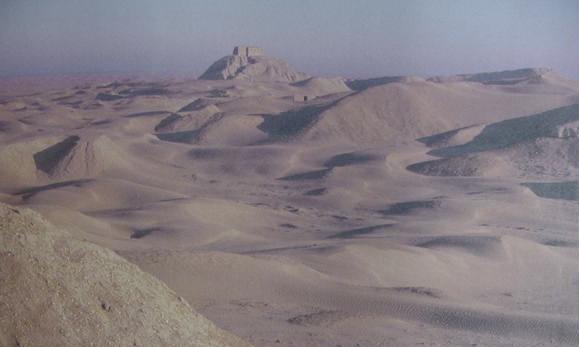
Below, a map of Nippur, after an ancient map of the city found on a clay tablet. Note the lower left corner of the city has an area marked off as "garden in the city" _within_ the city's wall. The Bible suggests for some commenators that the Garden in Eden also possessed a wall as Cherubim are later placed at the "entrance" to the garden to prevent man from re-entering and accessing the fruit on the Tree of Life. Other gardens or fields existed _outside_ the city's walls as well. The word paradise is understood by some to be Persian and means a "walled-garden." Nippur's walled garden certainly would fit the word paradise nicely (for the below map cf. p. 19. map titled: "Nippur, the sacred city of Sumer." Michael Wood. Legacy: The Search For Ancient Cultures. New York. Sterling Publishing Company. 1992).
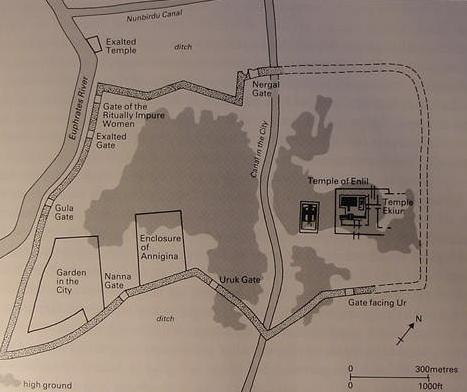
Professor Foster on the creation of man at Nippur to relieve the Igigi gods of their grievous toil:
"When the gods were man, they did forced labor, they bore drudgery. Great indeed was the drudgery of the gods, the forced labor was heavy, the misery too much: The seven (?) great Anunna-gods were burdening the Igigi gods with forced labor...[The gods] were digging watercourses, canals they opened, the life of the land...They heaped all the mountains. [ years] of drudgery, [ ] the vast marsh. They counted years of drudgery, [ and] forty years too much! [ ] forced labor they bore night and day. They were complaining, denouncing, muttering down in the ditch, "Let us face up to our foreman the prefect, He must take off this our heavy burden upon us!
(pp. 52-3, "The Story of the Flood," [The Atrahasis version]." Benjamin R. Foster. From Distant Days, Myths Tales and Poetry of Ancient Mesopotamia. Bethesda, Maryland, CDL Press, 1995, ISBN 1-883053-09-9, paperback)
The Anunna gods acknowledge the burden of the Igigi and their "clamor":
"Ea made ready to speak, and said to the gods [his brethren], what calumny do we lay to their charge? Their forced labor was heavy. [their misery too much]! Every day [ ] the outcry [was loud, we could hear the clamor]. There is [ ] [Belet-ti, the mid-wife], is present. Let her create, then a human, a man, let him bear the yoke...[let man assume the drud]gery of god...She summoned the Anunna, the great gods...Mami made ready to speak, and said to the great gods, "You ordered me the task and I have completed (it)! You have slaughtered the god, along with his inspiration. I have done away with your heavy forced labor, I have imposed your drudgery on man. You bestowed (?) clamor upon mankind..." (pp.58-59, Foster)
The Igigi gods in gratitude fall at her feet, kissing them, she having freed them from toil, and declare a new name for her "Mistress of All the gods" (Belet-kala-ili).
A CAVEAT ("WARNING"):
As can be seen from Professor Foster's above translation the Igigi gods are objecting to the making of watercourses and canals, NOWHERE does the text say they are working in the Anunnaki gods' city-gardens! So why am I claiming the Igigi worked in the Anunnaki gods' gardens?
I am stepping back and looking at the "big picture," or to put it another way "connecting the dots" (making INFERENCES)! We have two sets of gods dwelling in cities they have made for themseleves on the earth, the senior gods called the Anunnaki or Anunna and the junior gods called the Igigi. The Anunnaki are making the Igigi do the work. What is the purpose of canals and watercourses in Mesopotamia? Its not to water the grass lawns near the temples. The cities of Lower Mesopotamia are habitable only if a food-supply is available for the occupants.
The watercourses, canals and irrigation ditches MAKE POSSIBLE THE CITY-GARDENS OF THE GODS. Thus I INFER that when the Anunnaki sit down to a meal, they as the senior gods are not out in the hot sun planting the crops, nor are they hoeing out the weeds, nor are they harvesting the crops, nor are they preparing the crops for the table. The Anunnaki are eating the garden-produce and someone has to make all this "happen."
According to the myths Man has not yet been created, so that leaves the Igigi gods as bearing these burdens. That is to say it is my understanding that they not only are digging-out watercourses and canals, but irrigation ditches, and planting, hoeing and harvesting the crops to feed the Anunnaki as well as themselves.
When it is at last decided to REPLACE THE IGIGI WITH MAN, it is man who will now dig watercourses, canals, irrigation ditches and plant the crops, hoe them of weeds and harvest them and present them as food in the temples and shrines to the Anunnaki and the Igigi. Hence the reason I understand that the Igigi were burdened with toil in the gods' gardens. The gods' gardens cannot exist without water from man-made watercourses, canals and irrigation ditches.
George (a Professor of Babylonian at the University of London's School of Oriental and African Studies) suggests that THE IGIGI WERE TASKED WITH GARDENING DUTIES: planting, harvesting and preparing crops for the table in addition to making canals and irrigation ditches (Emphasis mine):
"We know from many ancient Mesopotamian sources, in Sumerian and in Akkadian, that the Babylonians believed the purpose of the human race to be the service of the gods. BEFORE MANKIND'S CREATION, the myth tells us, the cities of lower Mesopotamia were inhabited by the gods alone and they had to feed and clothe themselves by their own efforts. Under the supervision of Enlil, the lord of the earth, THE LESSER DEITIES GREW AND HARVESTED THE GODS' FOOD, TILLED THE SOIL and most exhaustingly, dug the rivers and waterways THAT IRRIGATED THE FIELDS...Eventually the labour became too much for them and they mutinied."
(p. xxxvii. "Introduction." Andrew George. The Epic of Gilgamesh. The Babylonian Epic Poem and Other Texts in Akkadian and Sumerian. London. Penguin Books. 1999)
I understand that the "irrigated fields" ARE THE CITY GARDENS OF THE GODS, which provide them with food. Man is created to replace the mutinous Igigi gods. Man's destiny is to toil in the Gods' gardens for evermore, providing the Anunna and Igigi gods with food, releasing them from agricultural toil upon the earth. Genesis' notion that God made man and placed him in his garden in Eden, is then, for me a later Hebrew recasting of the Mesopotamian myths about man being made and placed in the gods' gardens to relieve them of toil. The Hebrews in RECASTING these Mesopotamian myths regarding how, why, when, where man was created ARE REFUTING, DENYING AND CHALLENGING this presentation of the relationship between Man and his God.
Man is made of clay at Nippur under the god Ea's (Sumerian Enki) direction. This clay (titti) is given life or animated by being mixed with the flesh and blood of the Igigi god considered to be the ringleader of the Igigi rebellion against Enlil of Nippur. That is to say Man's REBELLIOUSNESS to a god is because he has in his body the REBELLIOUS SPIRIT of the slain Igigi god. The Hebrews are REFUTING this notion, portraying Adam as REBELLING against Eden's God as an act of freewill, by eating the forbidden fruit. For the Mesopotamians MAN IS THE VICTIM OF THE GODS. For the Hebrews GOD IS THE VICTIM of a rebellious ungrateful mankind whom he wishes to shower with love and fellowship.
Professor Sayce (1912) understood that Eden was the Babylonian plain between the Tigris and Euphrates rivers and the "garden of Eden" was watered by these rivers and was principally a plantation of fruit trees:
"The Babylonian plain was called the Land of Eden by its inhabitants -Eden signifying a plain in the primitive language of Babylonia. It was in this plain that the garden was situated. It was not a garden in our sense of the term. The word signified what we would now call a plantation mainly of fruit trees...It was thus the annual flood of the Babylonian rivers which irrigated Paradise."
(p. 145. Professor Sayce, John Jackson, L. W. King, F. R. Maunseh & William Willcocks. "The Garden of Eden and its Restoration: Discussion." The Geographical Journal. Vol. 40. No. 2 (August 1912). pp. 145-148)
Smith (1893) on Eridu (Guruduga) being identified with the Bible's Garden of Eden by scholars (Sayce of 1887):
"...modern scholars locate in southern Babylonia the city of Eridu or Guruduga, "the good city,"...divine paradise under the sea...situated within the abyss (abzu, "the abode of knowledge")...the abode of the god of knowledge...its king was Ea and Damkina or Dauke was the queen."
(p. 850. Vol. 1. part 1. "Eden." William Smith & J. M. Fuller. Editors. A Dictionary of the Bible. London. John Murray. 1893. 2d edition)
Three different myths credit Enki/Ea with creating man at three locations: (1) Eridu, (2) Nippur, and (3) Babylon, to relieve the Igigi gods of toil. At the first two locations the Igigi gods are in open rebellion against Ea and Enlil, wanting an end of toil in the city-gardens. The Babylonian account has no rebellion by the gods warranting man's creation by Ea on Marduk's behalf.
The Hebrew patriarchs, Abraham through Jacob (called later Israel), are portrayed as tent-dwelling shepherds: "And you shall make response before the Lord your God, 'A wandering Aramean was my father" (King James Bible: "Syrian" Deut 26:5). They grazed their herds and flocks in the edin steppe lands extending from Ur of the Chaldees (Ge 11:28) south of Babylon, to Haran (Ge 11:31) in northern Syria, and Damascus (Ge 15:2) and thence south to Beersheba (Ge 21:33).
The city-dwellers of Mesopotamia held the tent-dwelling shepherds of the western lands (Martu, Amurru, Aram) in contempt and regarded them a menace to civilized life in the cities.
In defense of their way of nomadic herdsman life in the edin the Hebrew shepherds apparently recast the city-dwellers' myths about man's origins. God's delight was not a city, it was in the edin. He chose to tabernacle with man in a tent among nomadic shepherds instead of dwell with man in a city temple.
![]()
![]()
Disclaimer:
Some material presented will contain links, quotes, ideologies, etc., the contents of which should be understood to first, in their whole, reflect the views or opinions of their editors, and second, are used in my personal research as "fair use" sources only, and not espousement one way or the other. Researching for 'truth' leads one all over the place...a piece here, a piece there. As a researcher, I hunt, gather and disassemble resources, trying to put all the pieces into a coherent and logical whole. I encourage you to do the same. And please remember, these pages are only my effort to collect all the pieces I can find and see if they properly fit into the 'reality aggregate'.
Personal Position:
I've come to realize that 'truth' boils down to what we 'believe' the facts we've gathered point to. We only 'know' what we've 'experienced' firsthand. Everything else - what we read, what we watch, what we hear - is what someone else's gathered facts point to and 'they' 'believe' is 'truth', so that 'truth' seems to change in direct proportion to newly gathered facts divided by applied plausibility. Though I believe there is 'truth', until someone representing the celestial realm visibly appears and presents the heavenly records of Facts And Lies In The Order They Happened, I can't know for sure exactly what "the whole truth' on any given subject is, and what applies to me applies to everyone. Until then I'll continue to ask, "what does The Urantia Book say on the subject?"
~Gail Bird Allen
![]()
![]()

